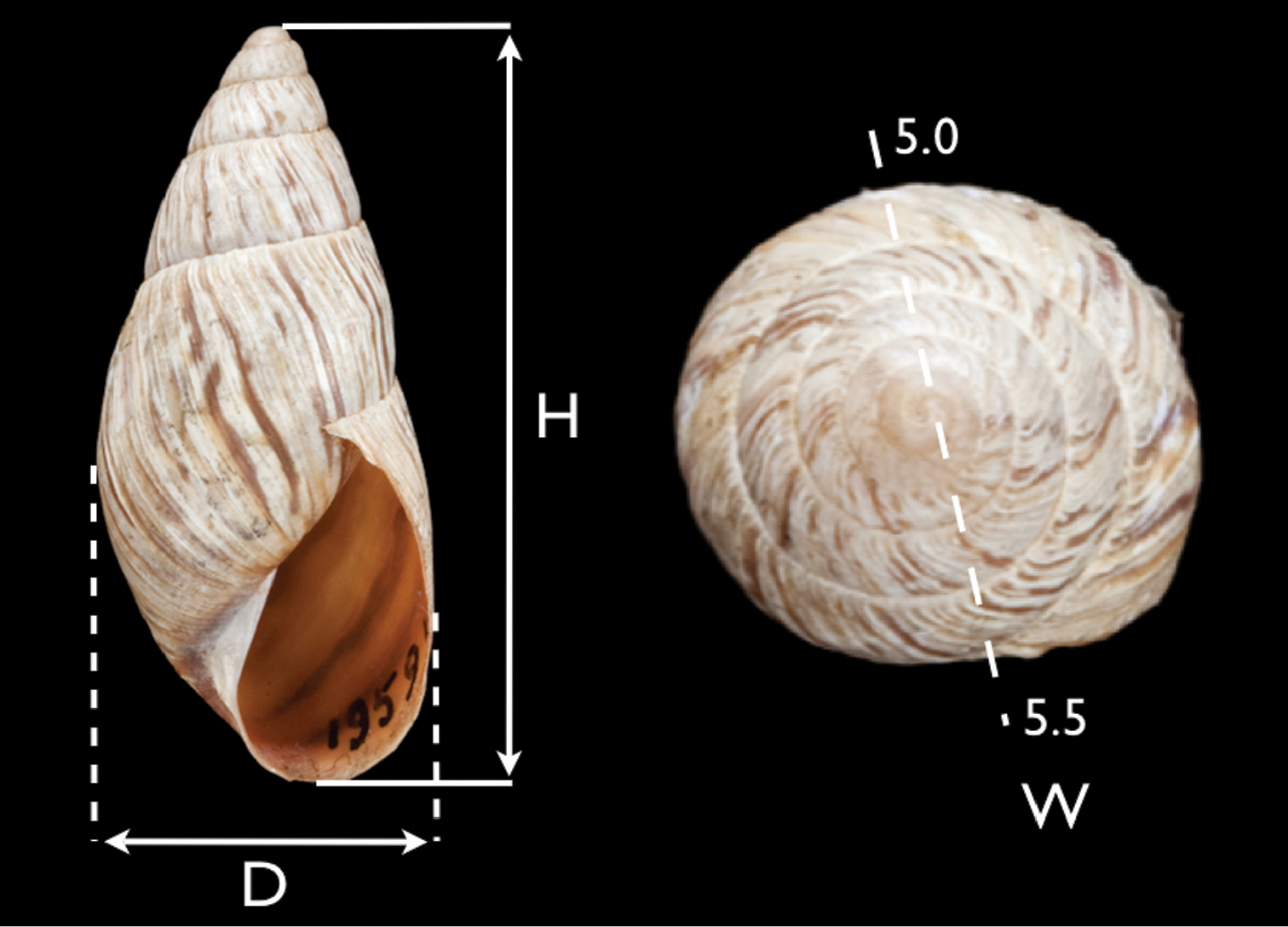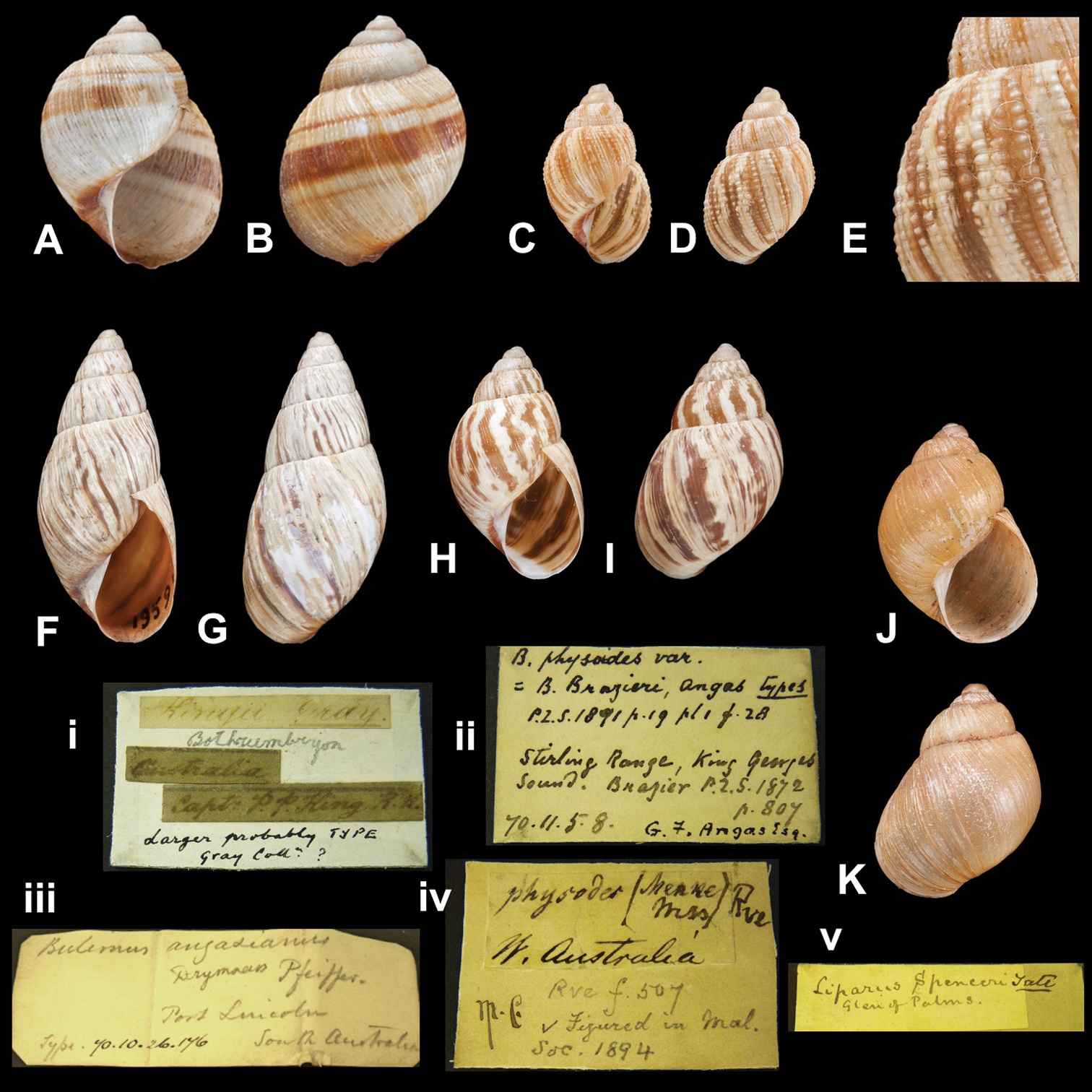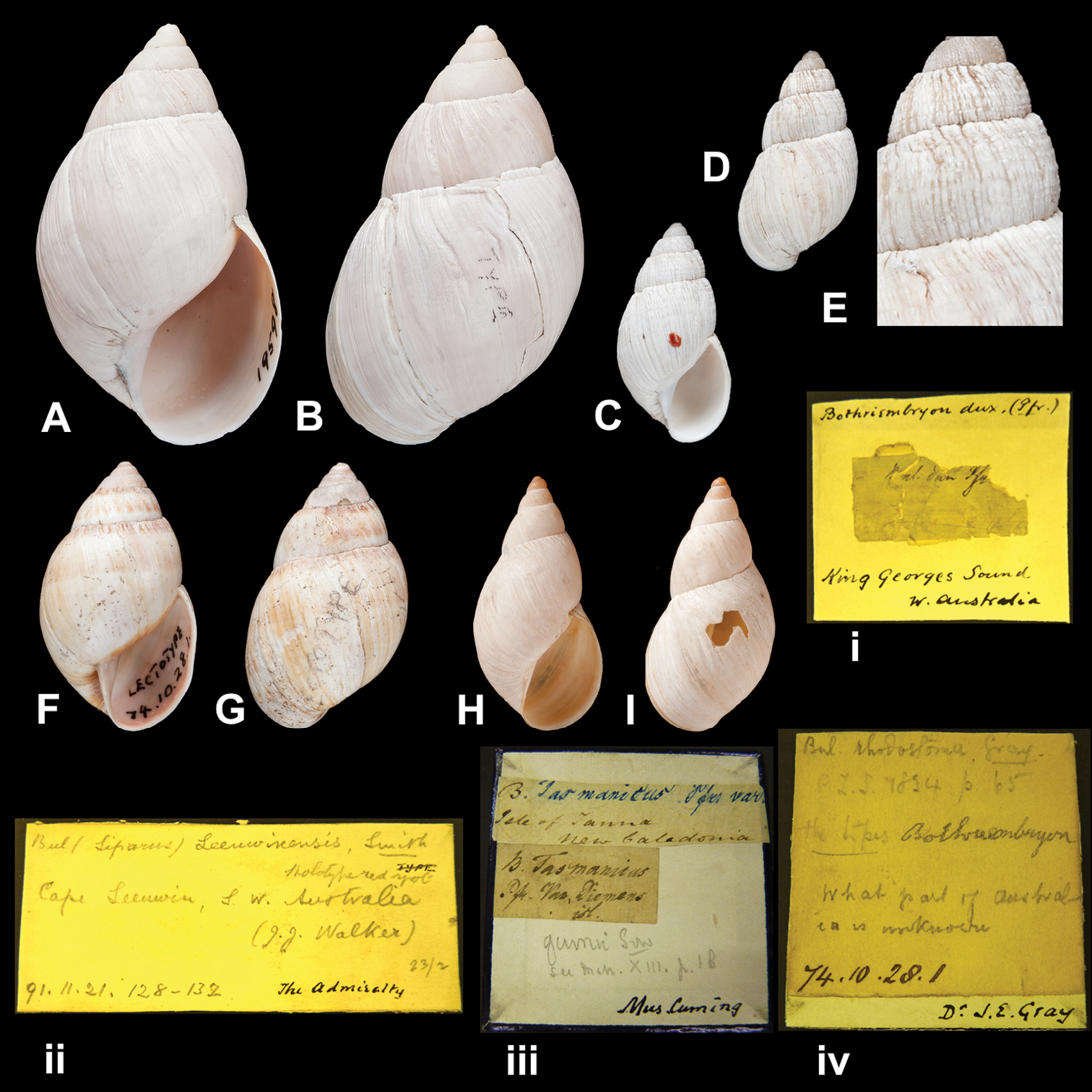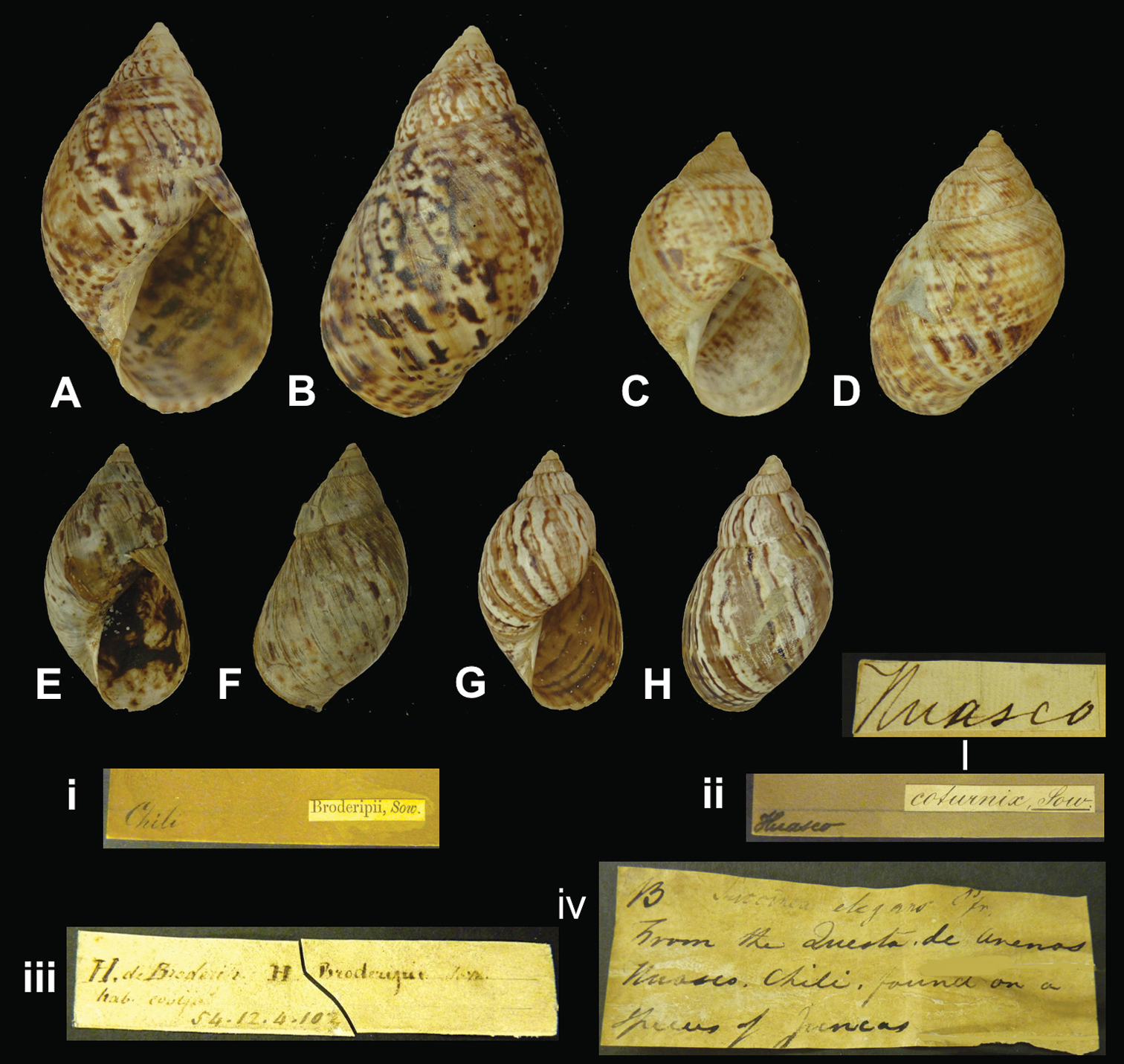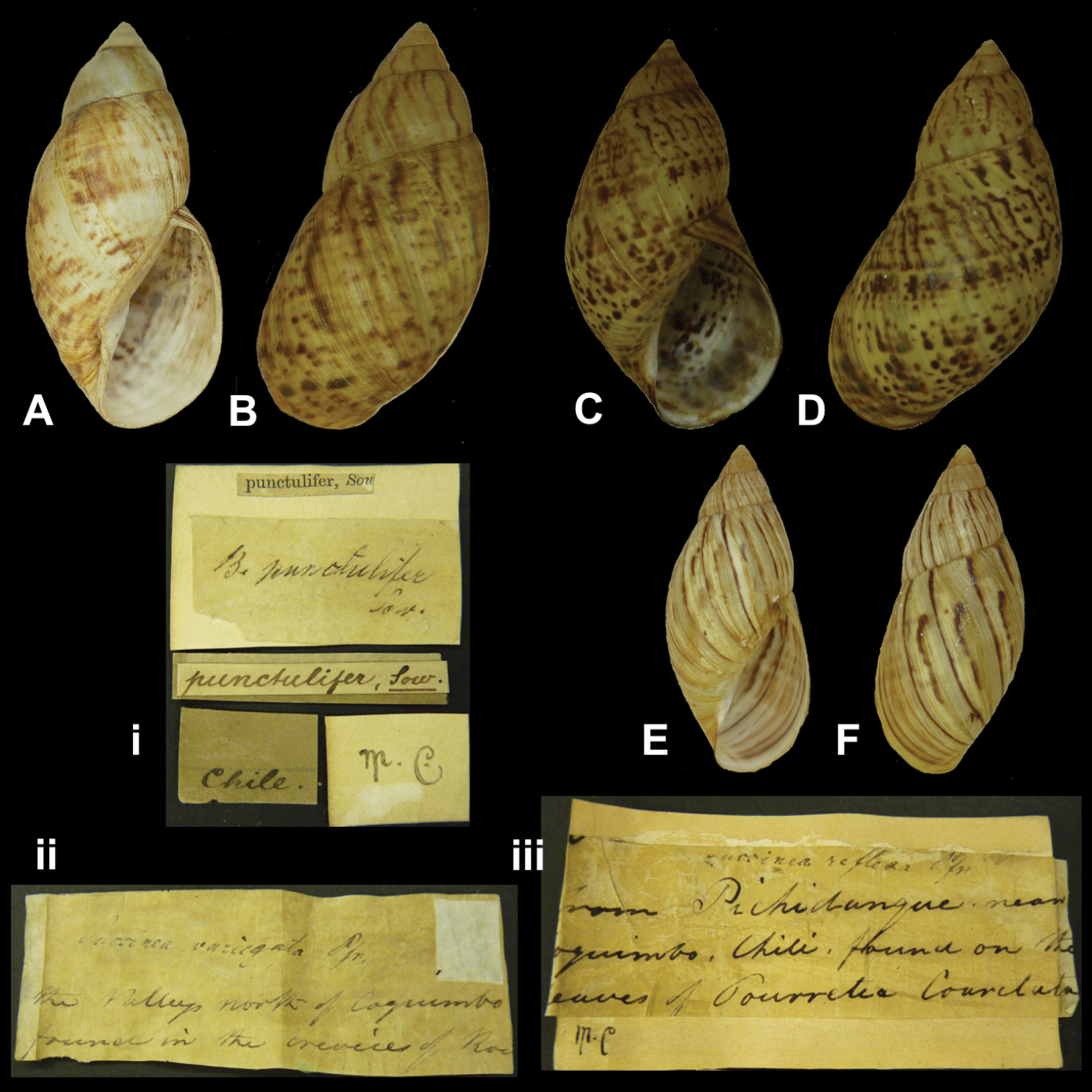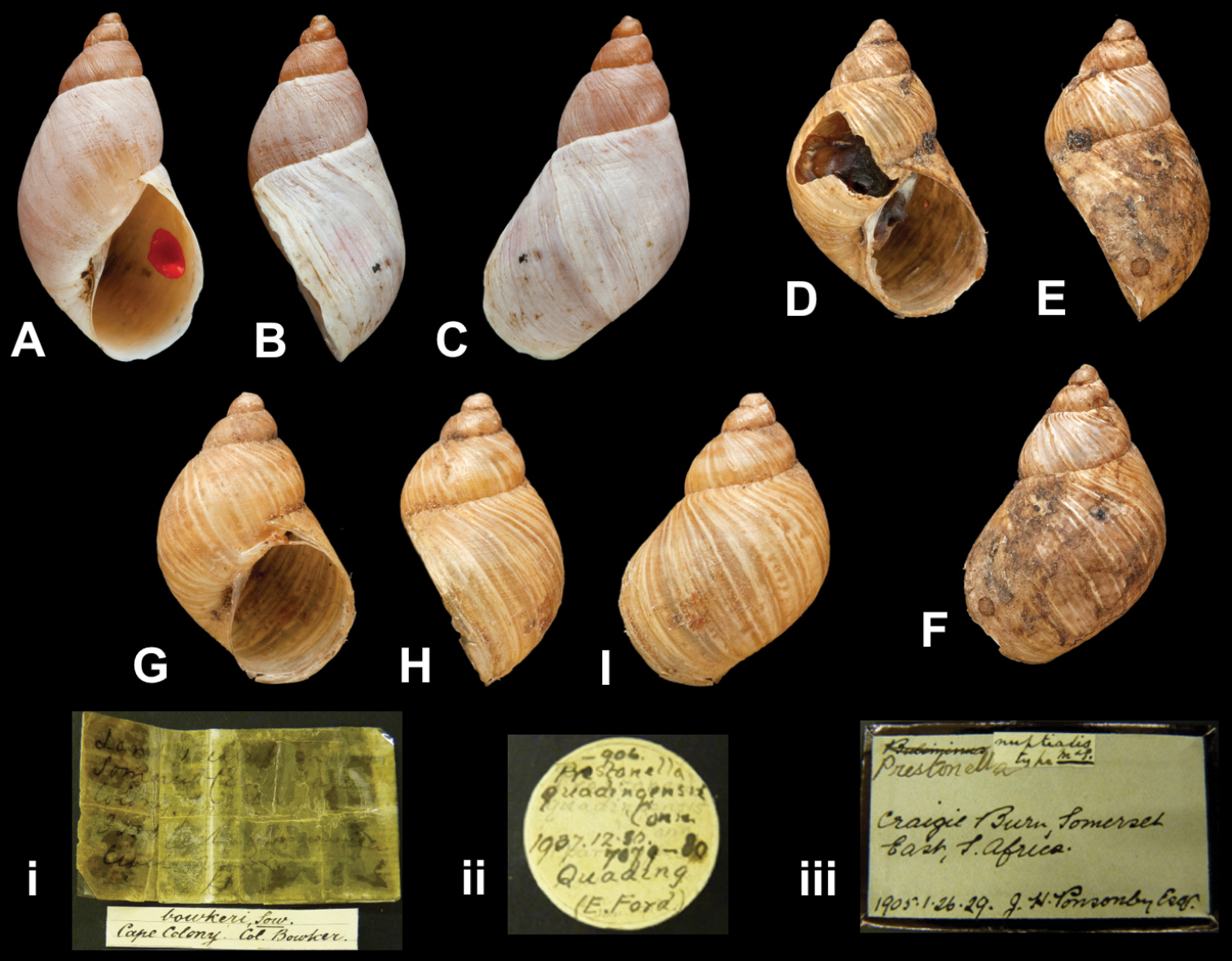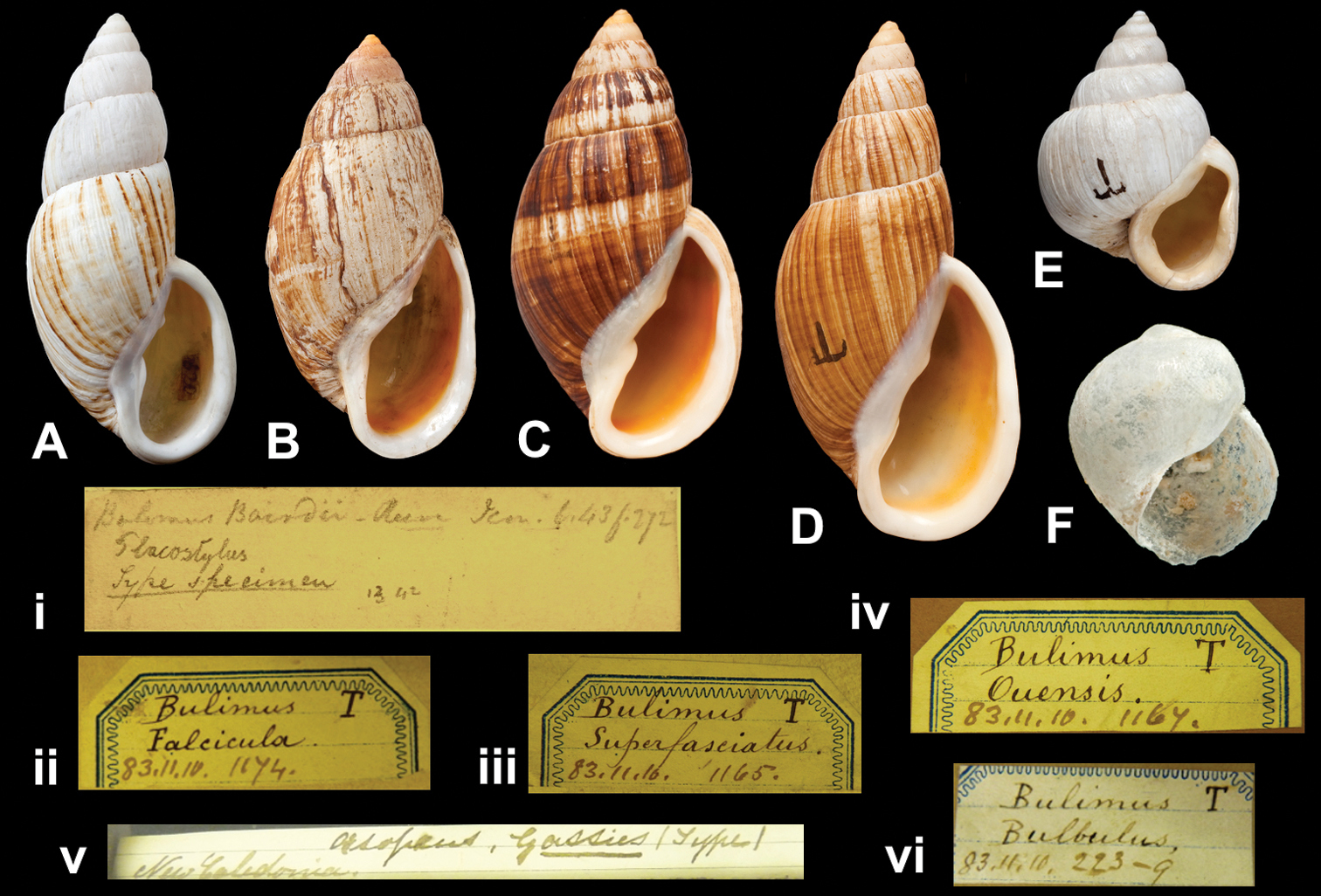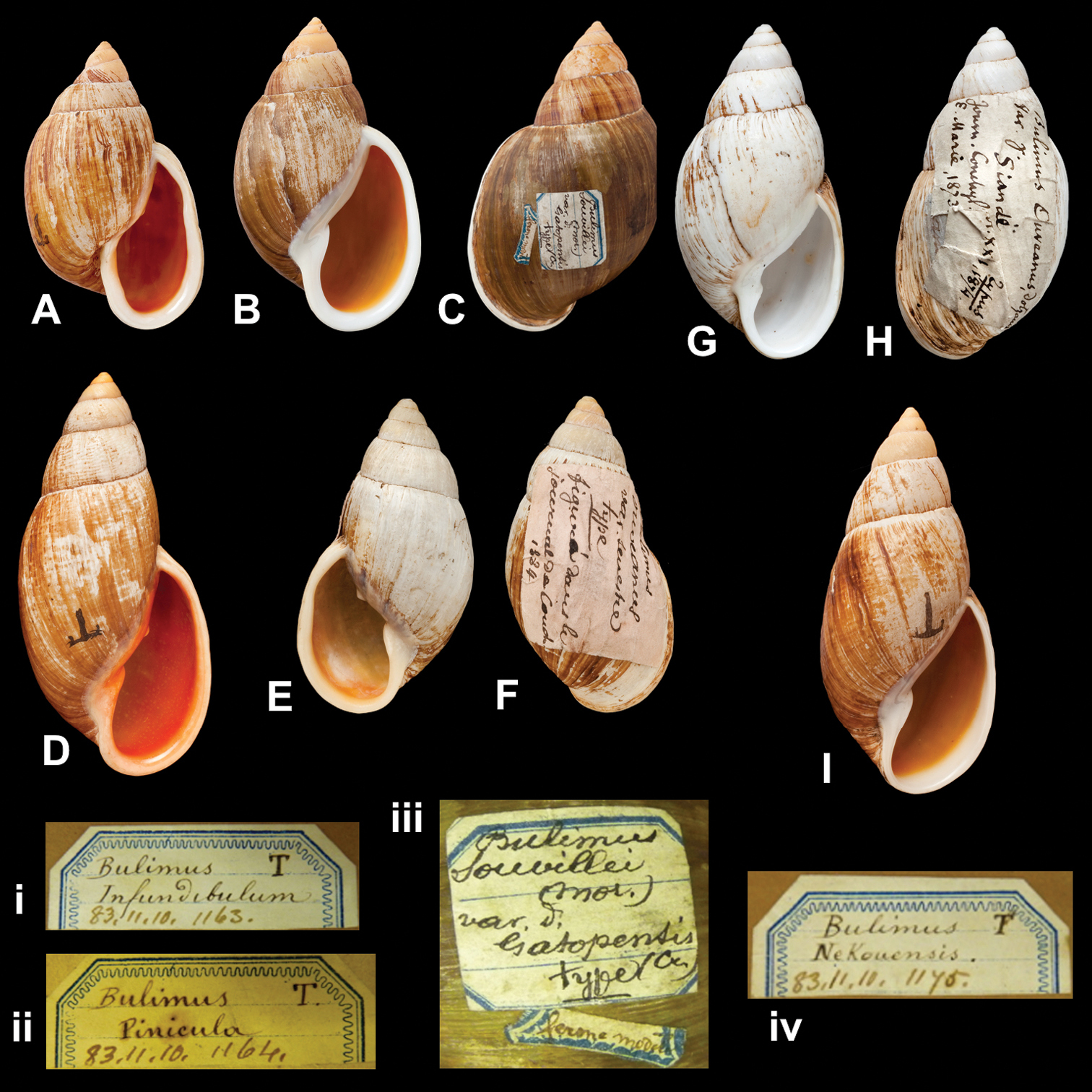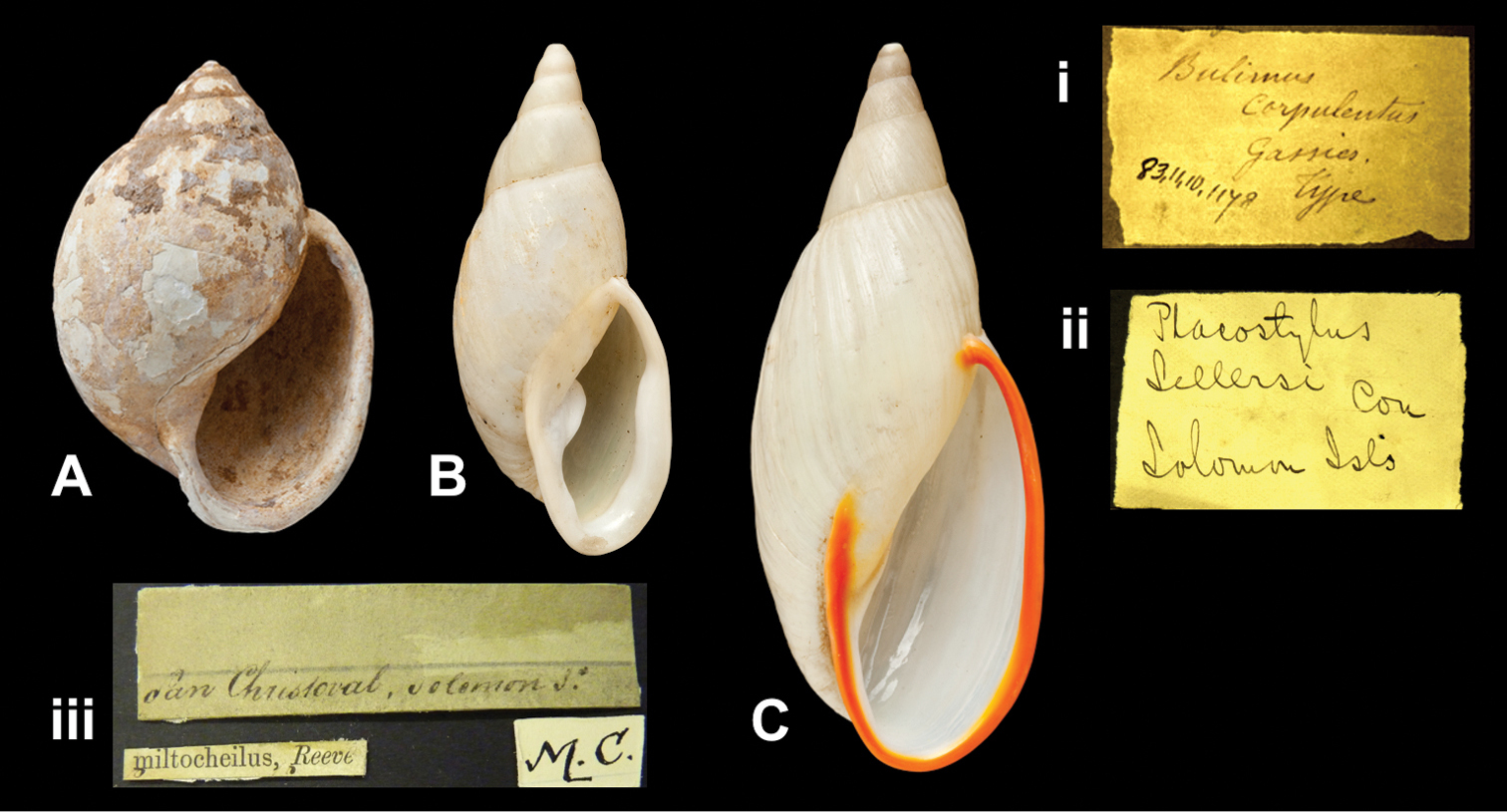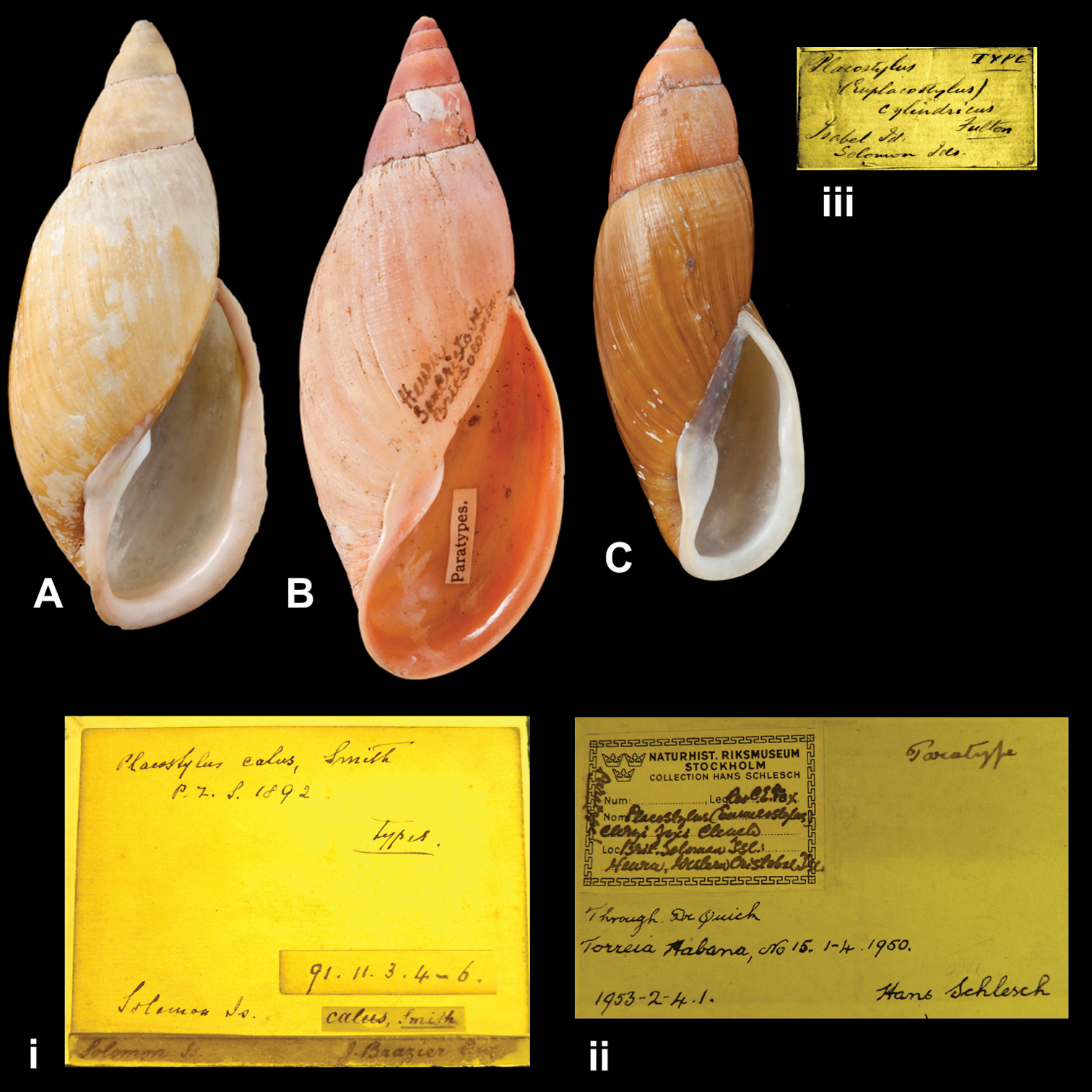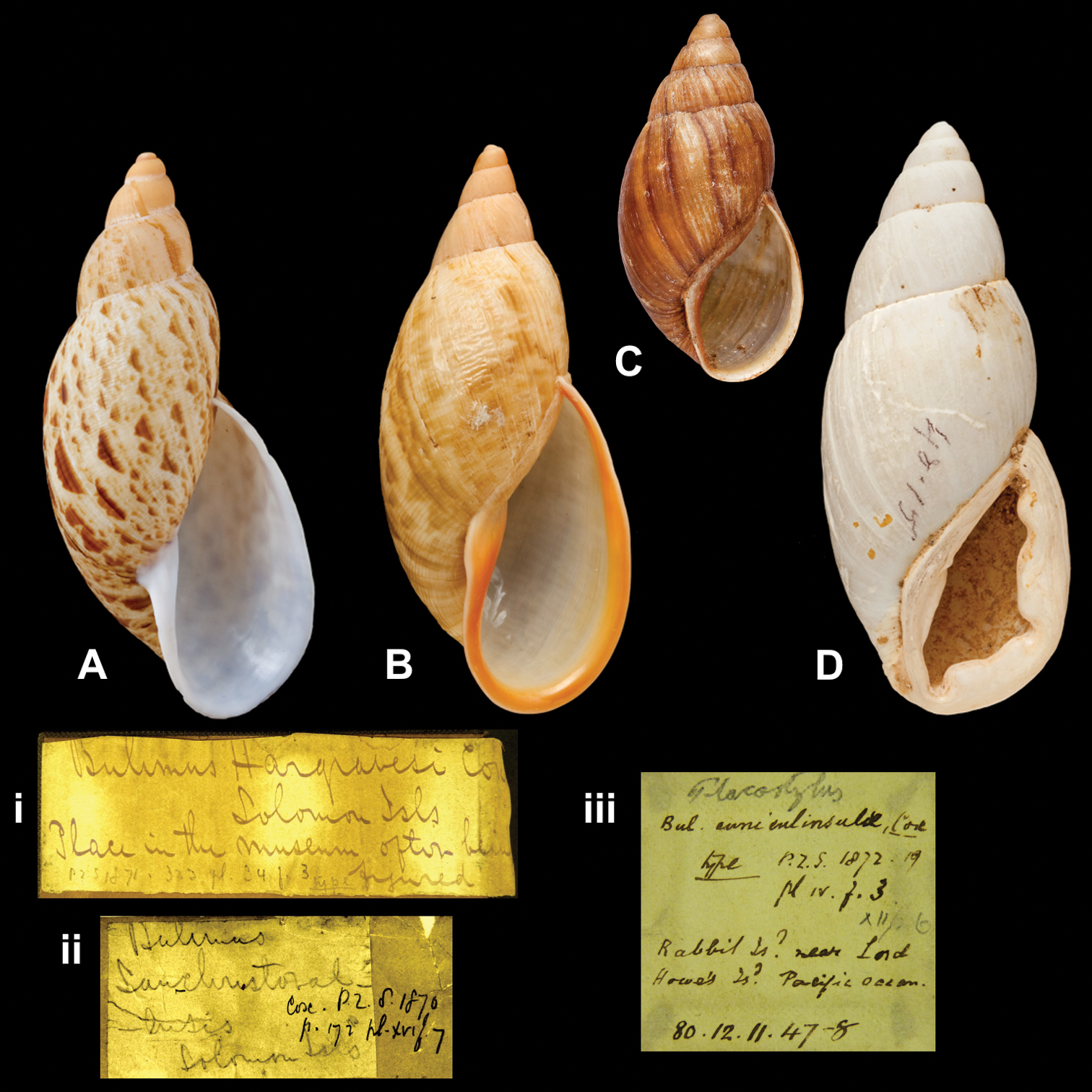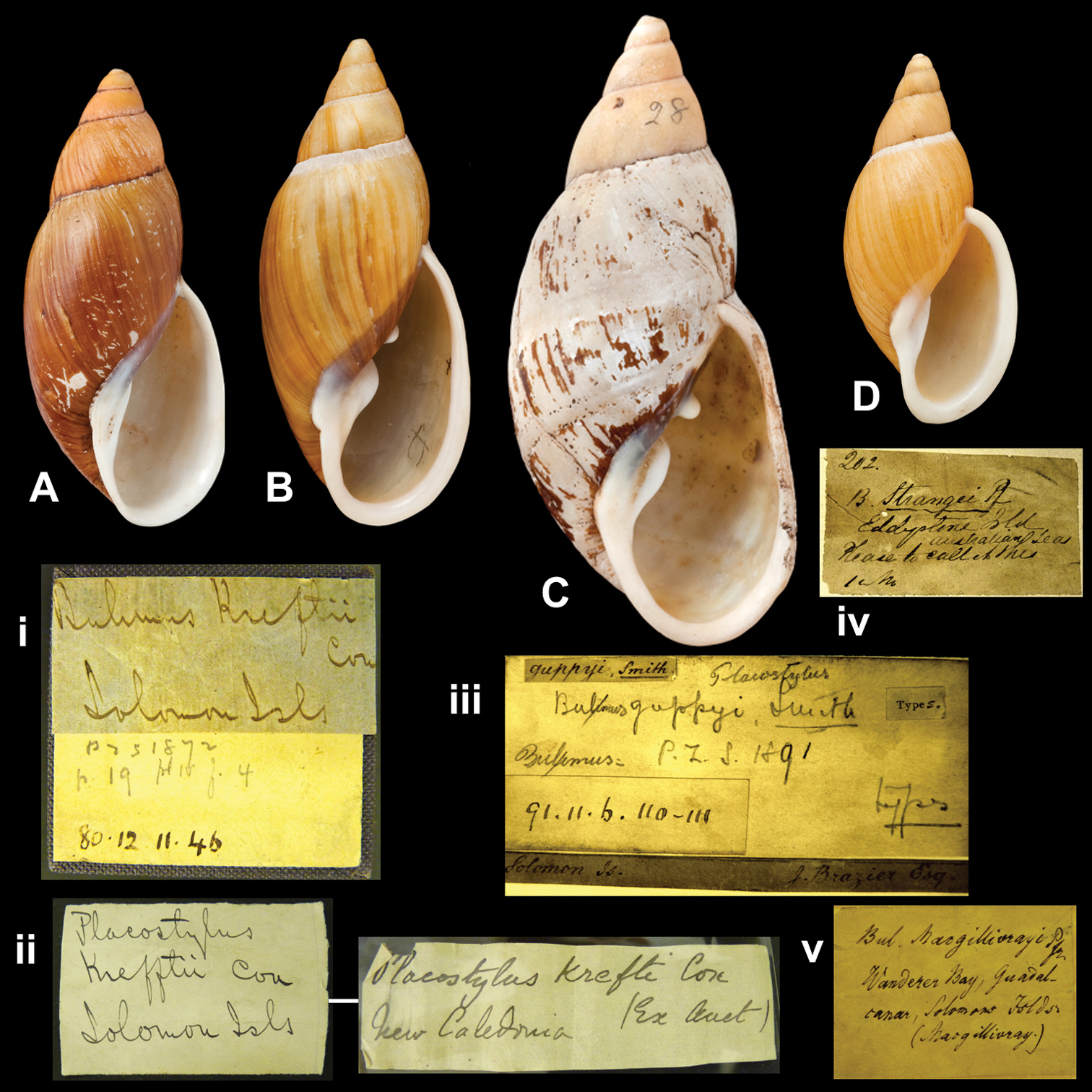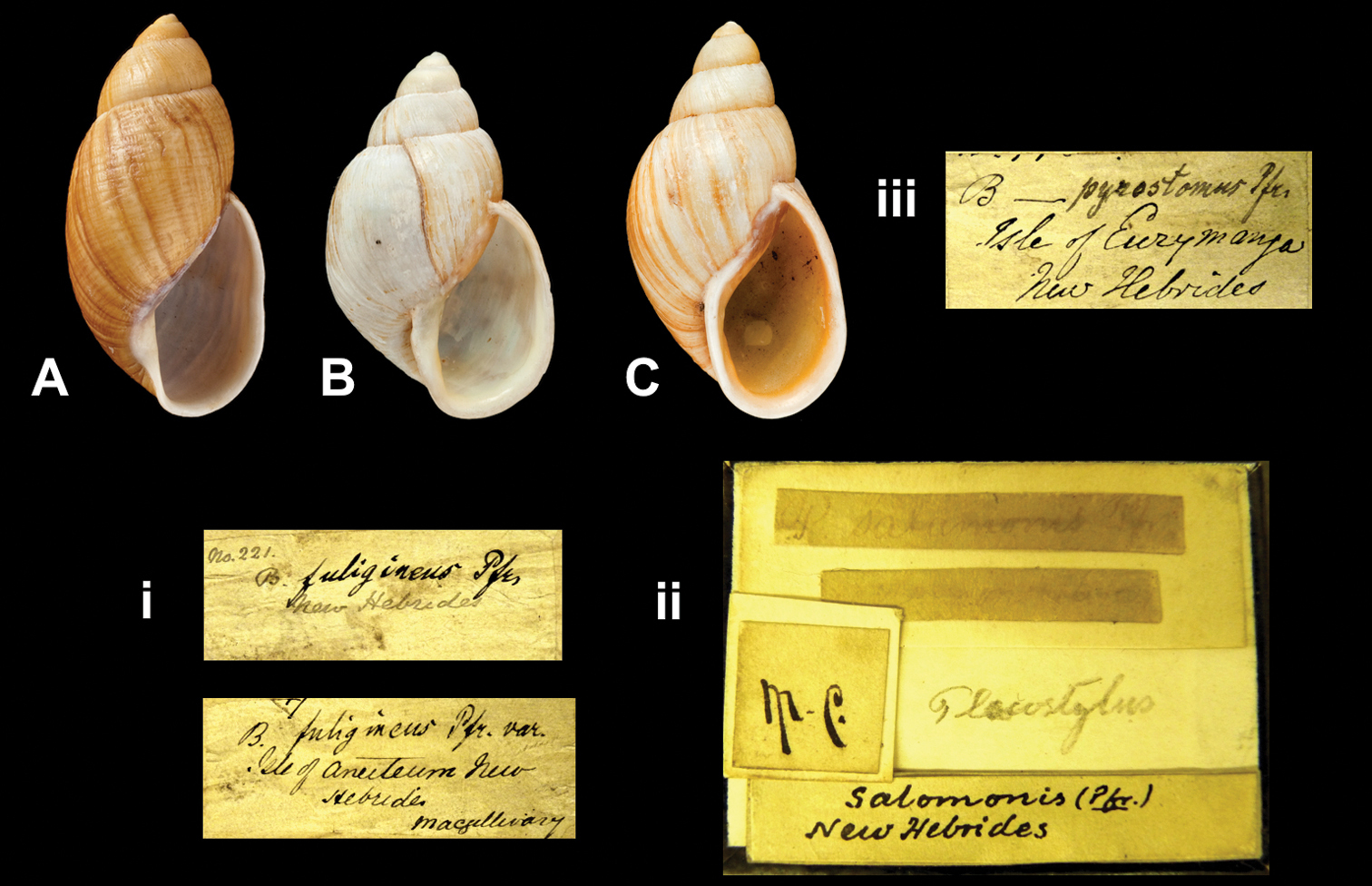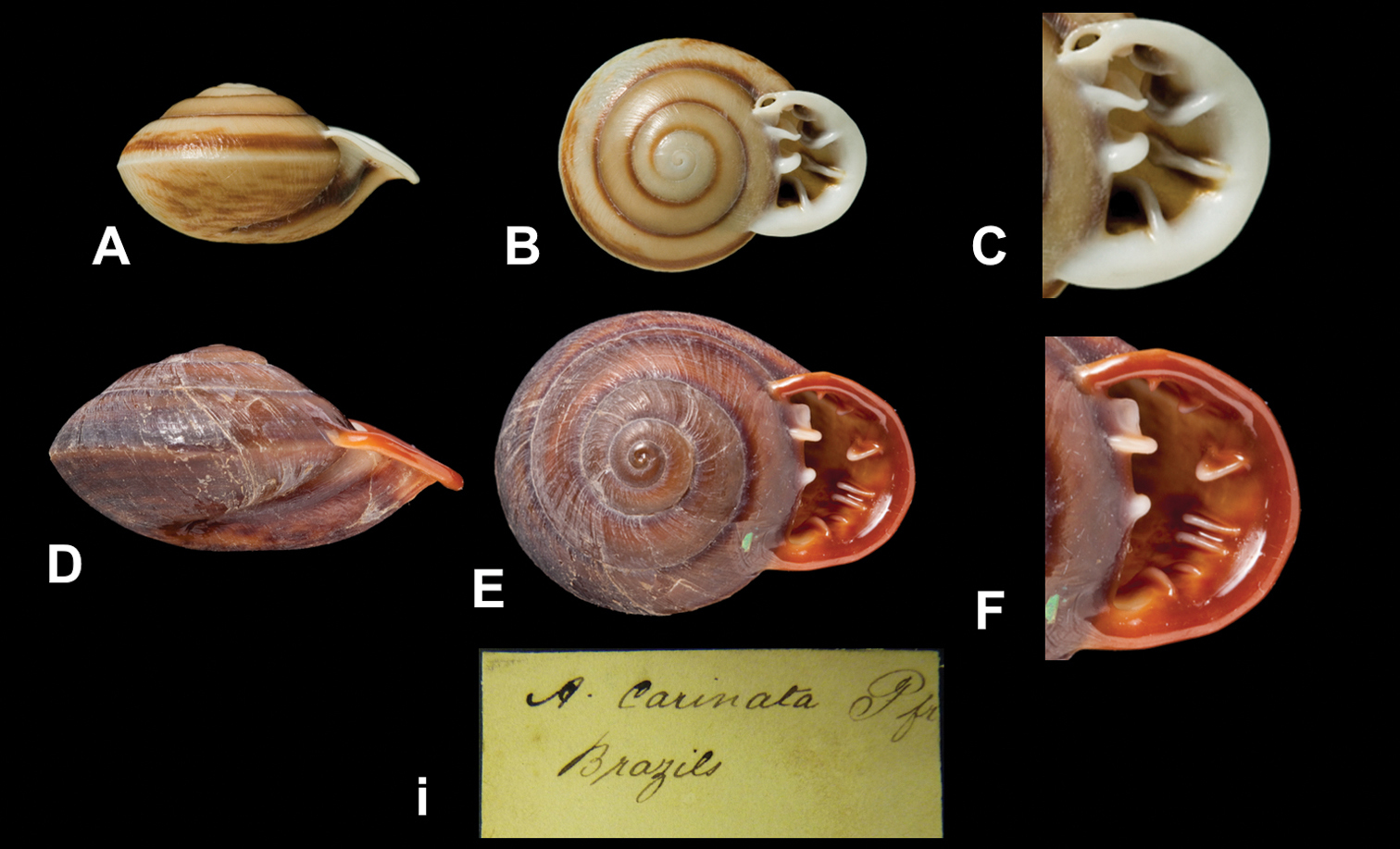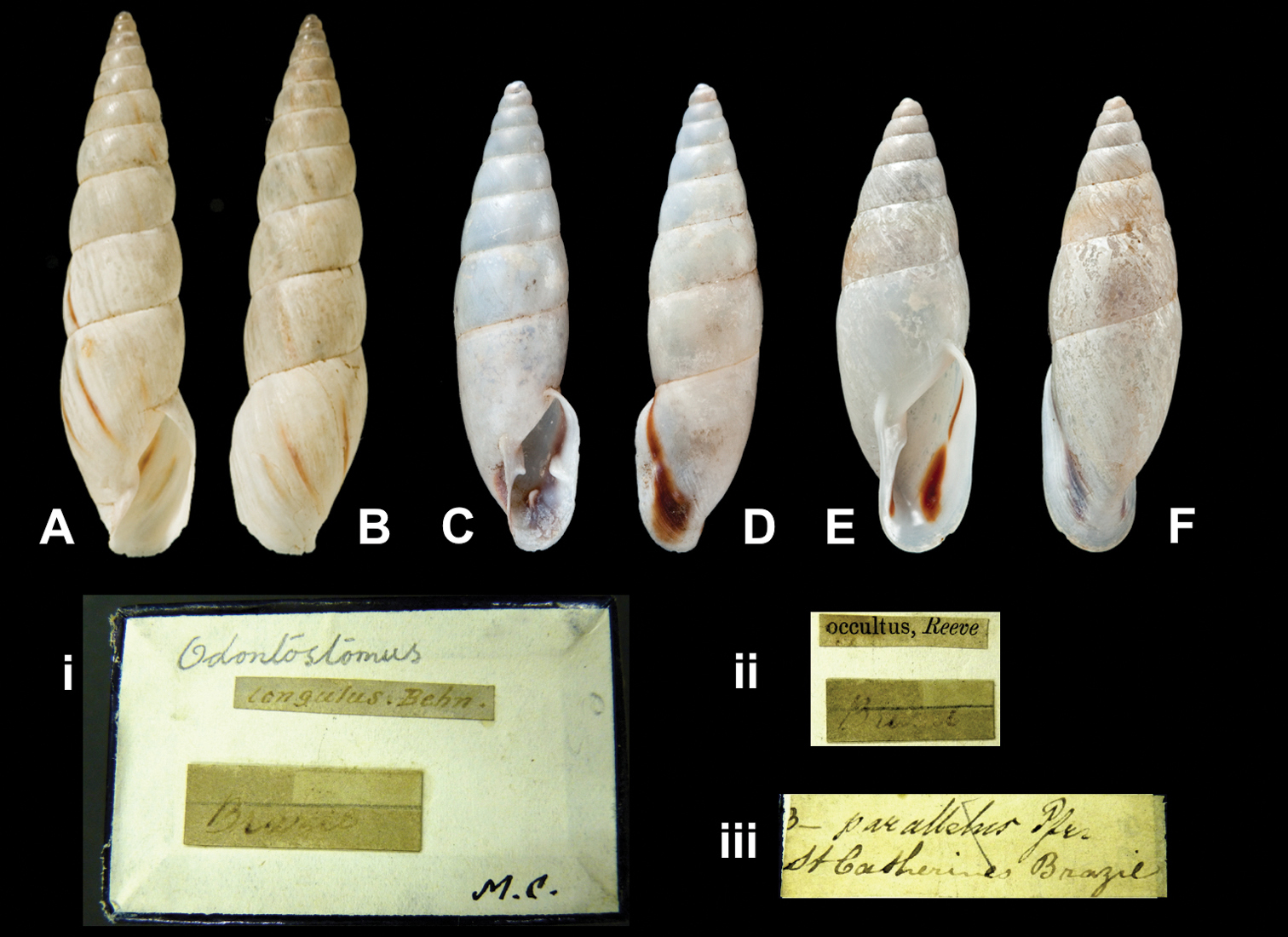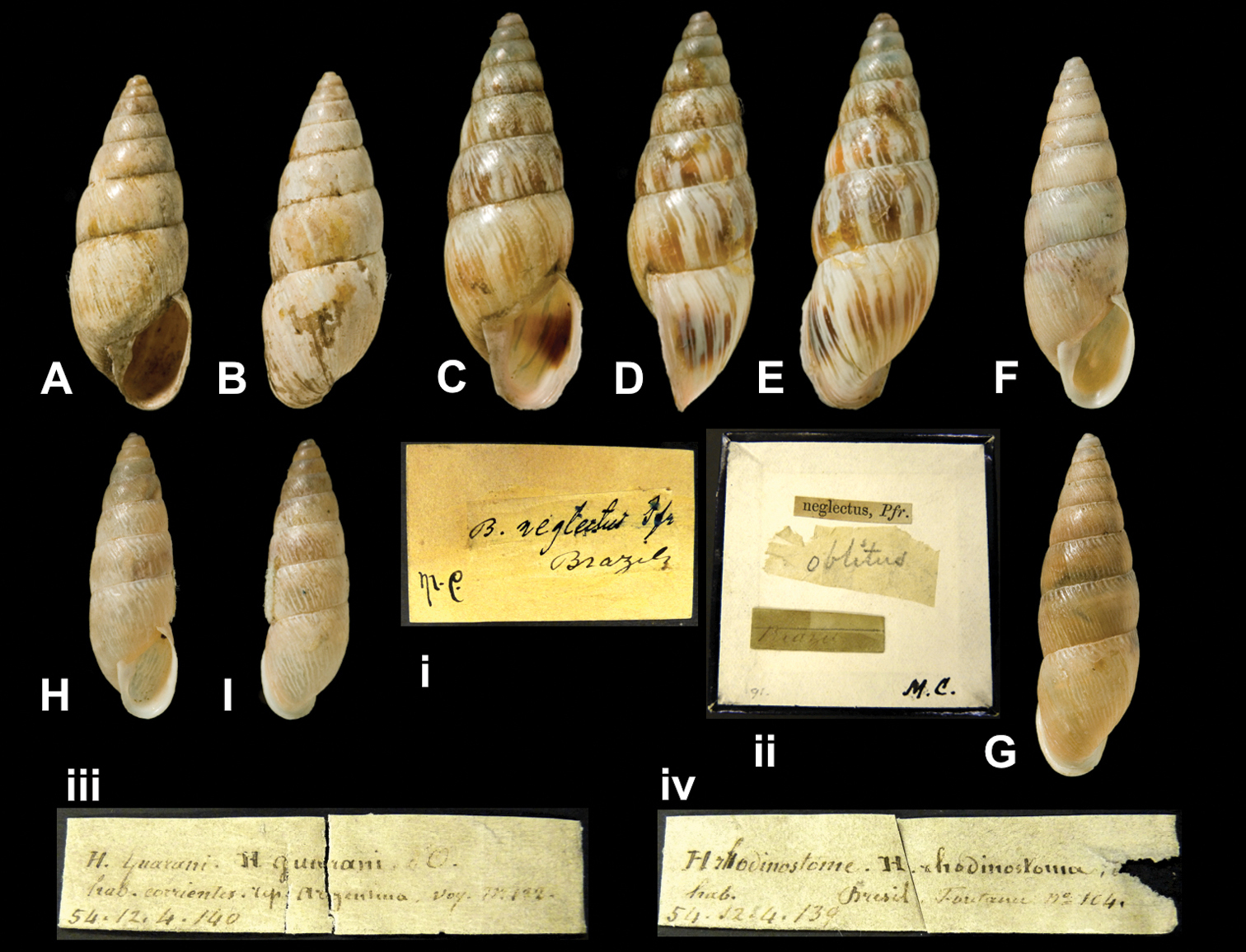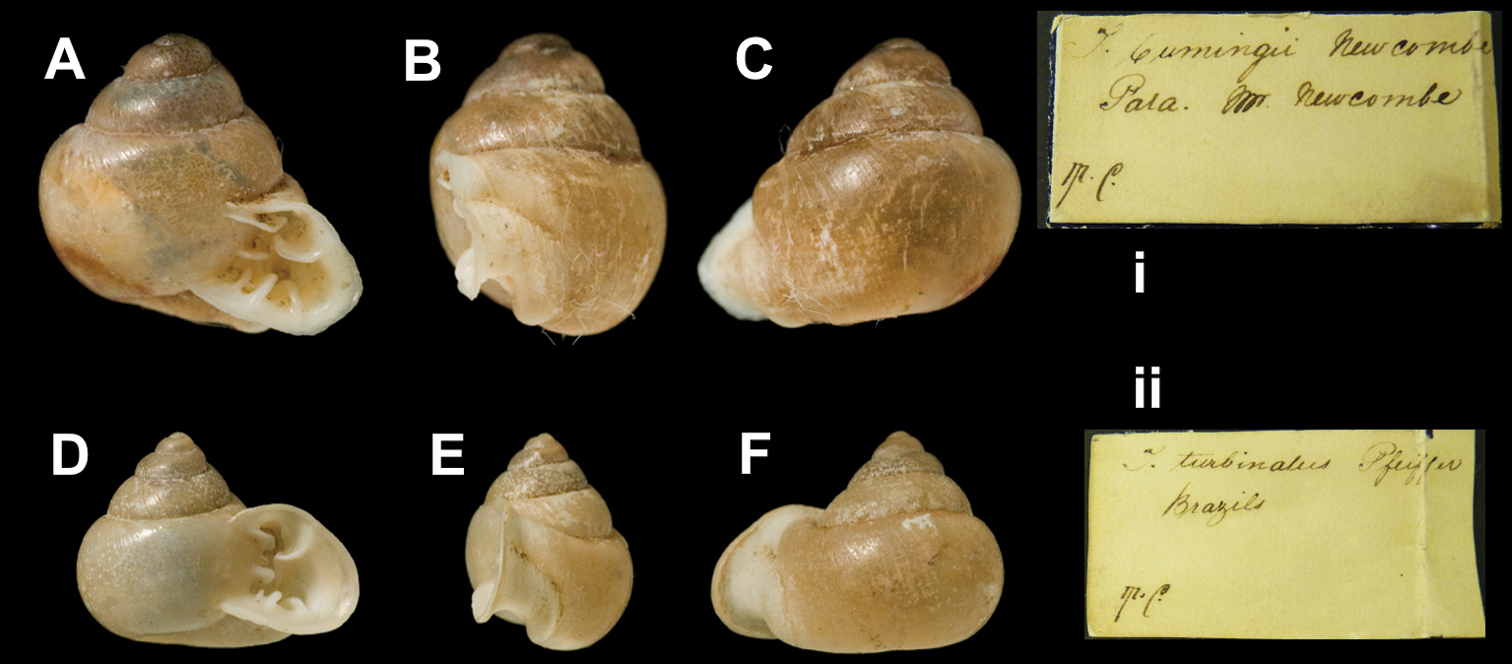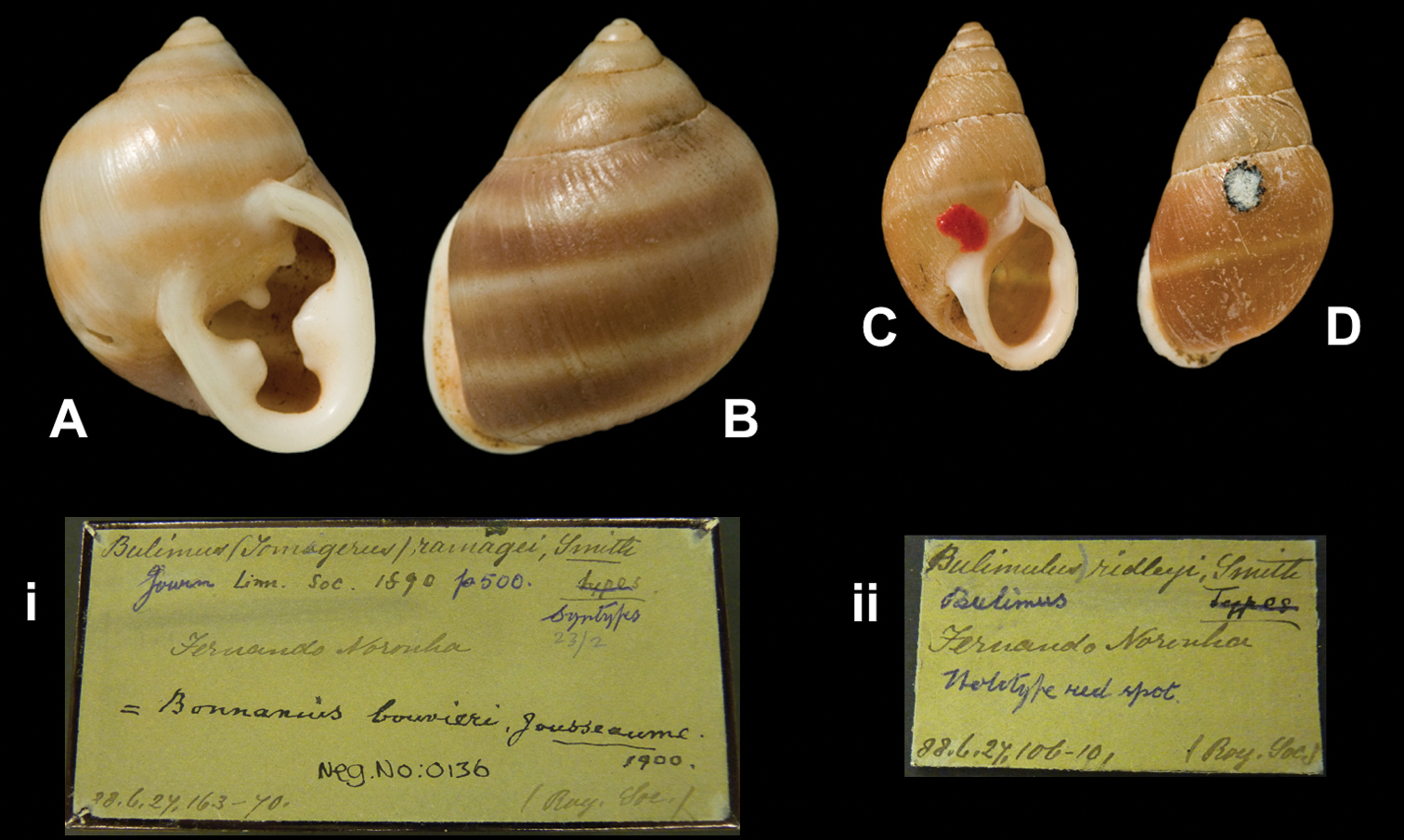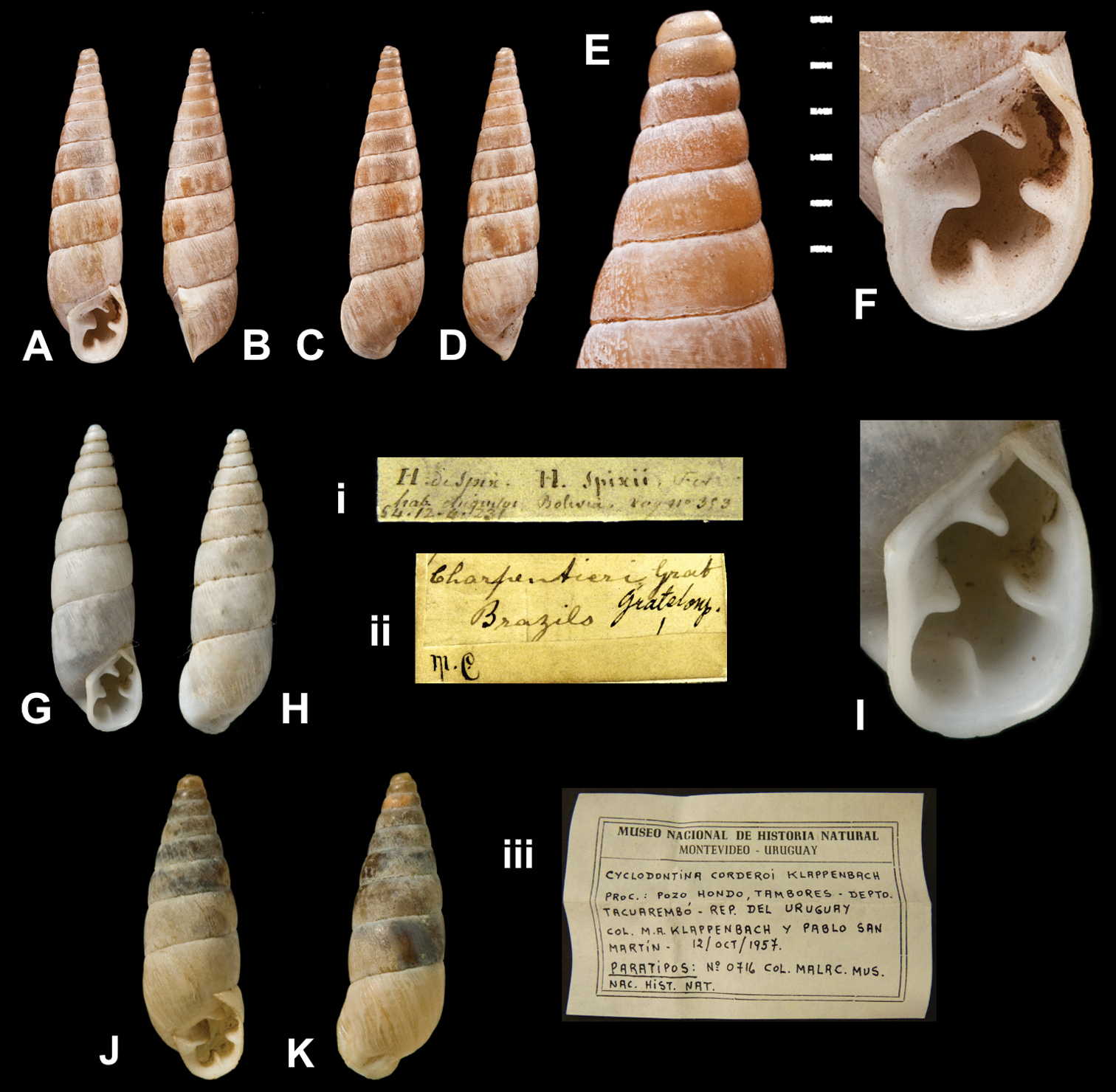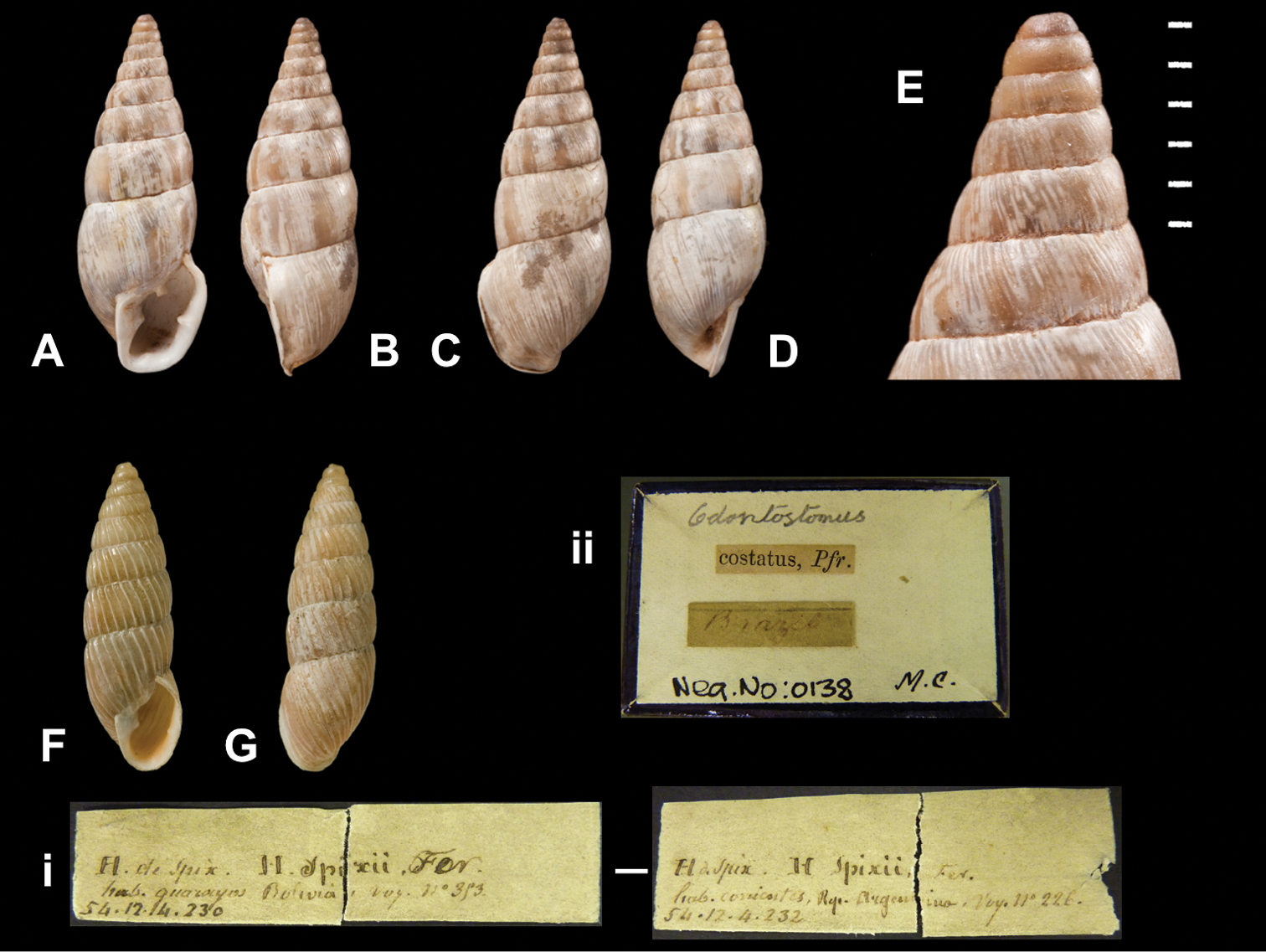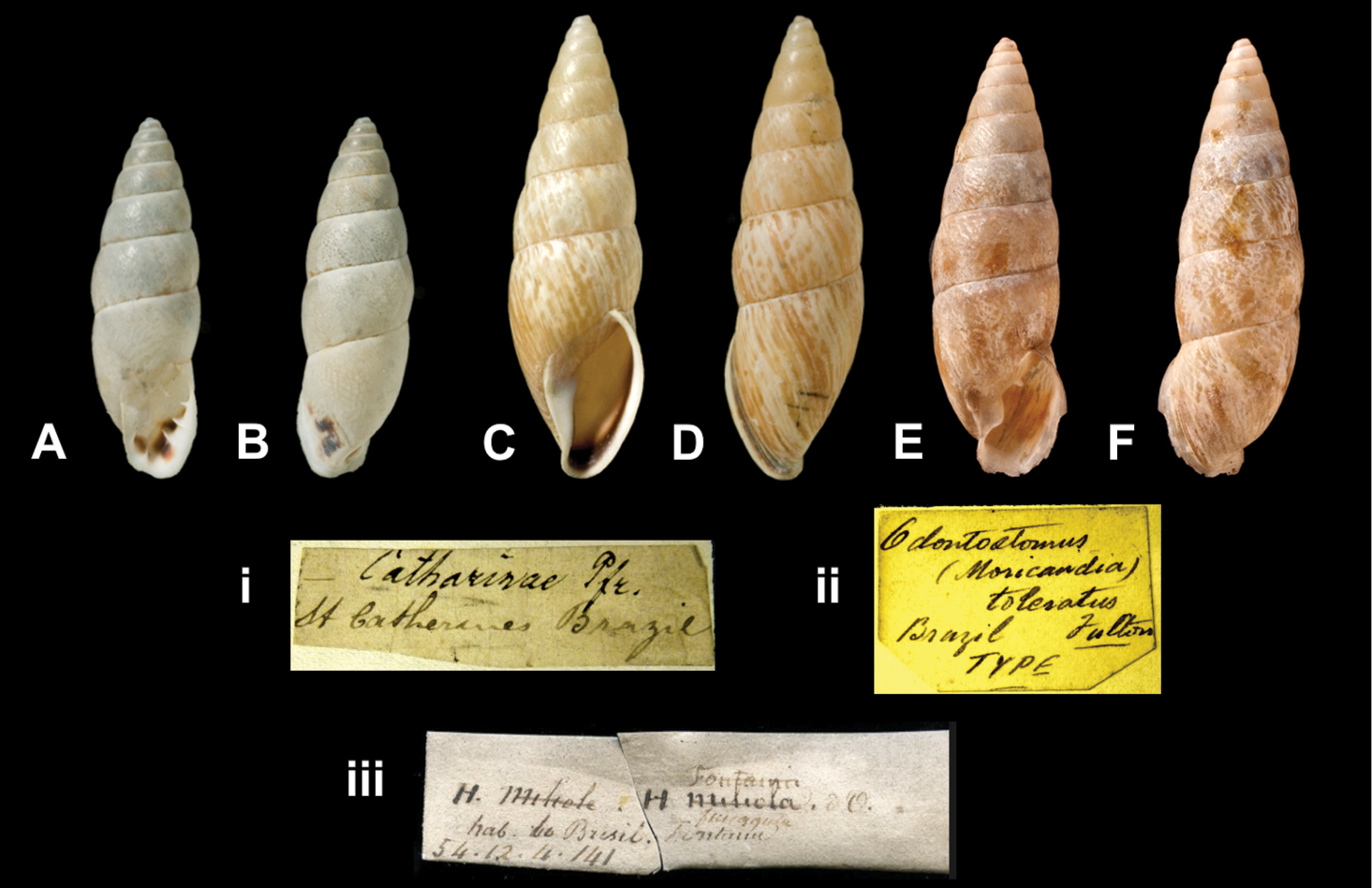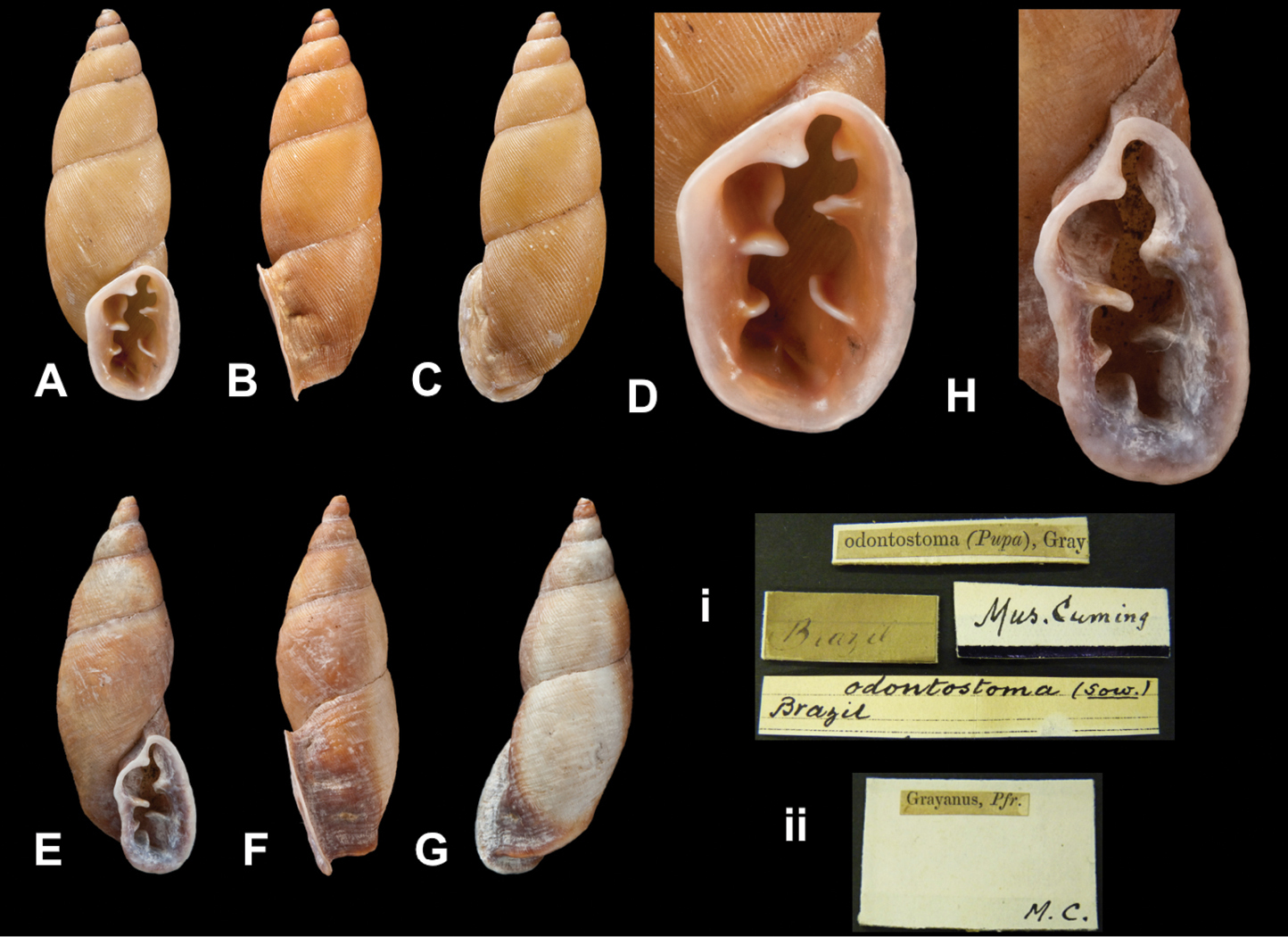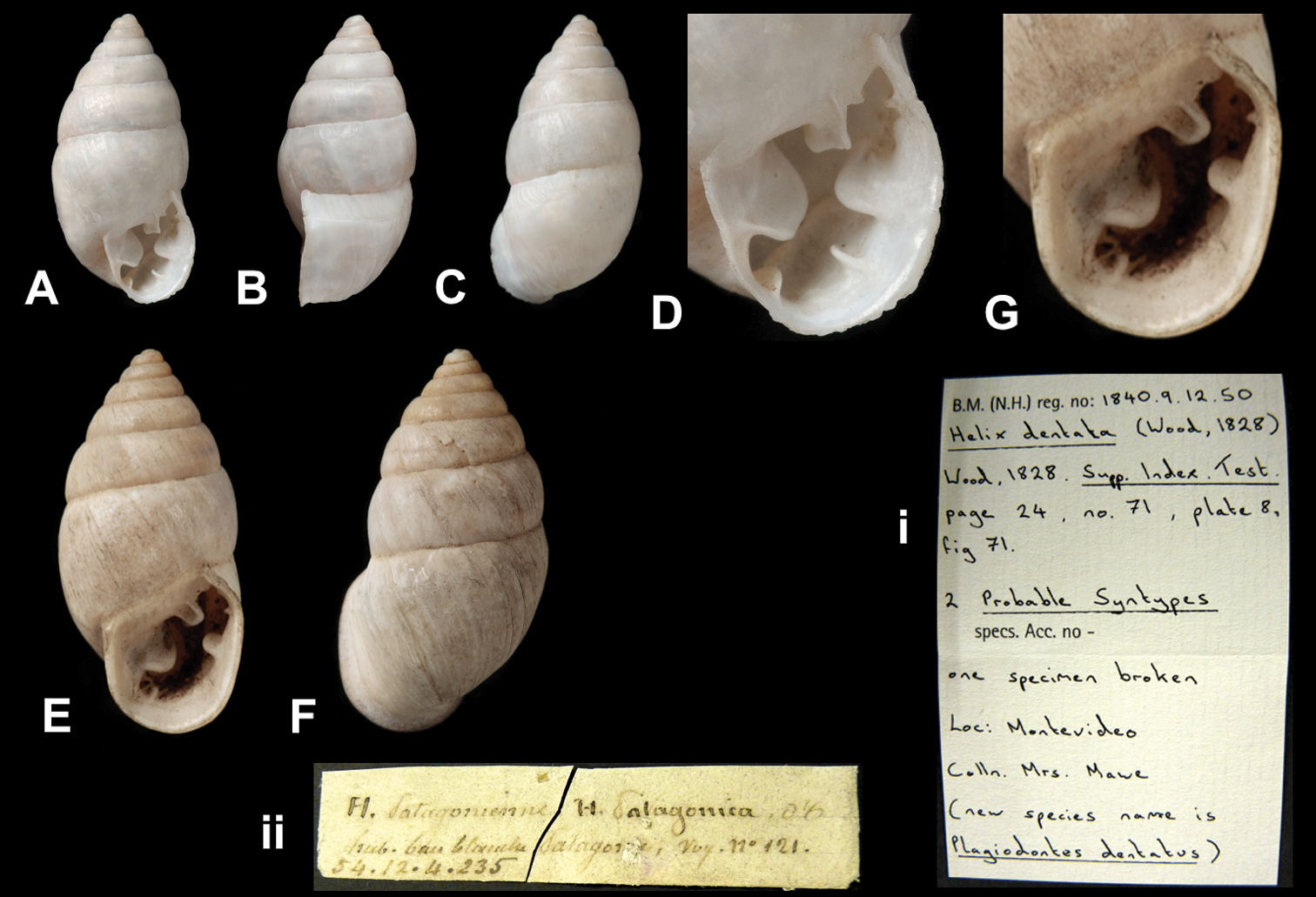






(C) 2012 Abraham S.H. Breure. This is an open access article distributed under the terms of the Creative Commons Attribution License 3.0 (CC-BY), which permits unrestricted use, distribution, and reproduction in any medium, provided the original author and source are credited.
For reference, use of the paginated PDF or printed version of this article is recommended.
The type status is described for specimens of 84 taxa classified within the families Bothriembryontidae and Odontostomidae (superfamily Orthalicoidea) and kept in the Natural History Museum, London. Lectotypes are designated for Bulimus (Liparus) brazieri Angas, 1871; Bulimus broderipii Sowerby I, 1832; Bulimus fuligineus Pfeiffer, 1853; Helix guarani d’Orbigny, 1835; Bulimus (Tomigerus) ramagei E.A. Smith, 1890; Helix rhodinostoma d’Orbigny, 1835; Bulimus (Bulimulus) ridleyi E.A. Smith, 1890. The type status of the following taxa is changed to lectotype in accordance with Art. 74.6 ICZN: Placostylus (Euplacostylus) cylindricus Fulton, 1907; Bulimus pyrostomus Pfeiffer, 1860; Bulimus turneri Pfeiffer, 1860. The following taxon is synonymised: Bulimus oblitus Reeve, 1848 = Bahiensis neglectus (Pfeiffer, 1847).
Bothriembryontidae, Odontostomidae, types
This is the second paper on the types of Orthalicoidea in the Natural History Museum, London. An earlier paper (
Abbreviations used for depositories of material are: ANSP, Academy of Natural Sciences, Philadelphia, U.S.A.; MHNG, Muséum d’Histoire Naturelle, Geneve, Switserland; MNHN, Muséum National d’Histoire Naturelle, Paris, France; MNHNM, Museo Nacional de Historia Natural, Montevideo, Uruguay; NHMUK, Natural History Museum, London, U.K.; RBINS, Royal Belgian Institute of Natural Sciences, Brussels, Belgium; RMNH, Netherlands Centre for Biodiversity Naturalis, Leiden, the Netherlands; SMF, Senckenberg Natur-Museum, Frankfurt am Main, Germany; UF, Florida Museum of Natural History, Gainesville, U.S.A.; ZMB, Museum für Naturkunde, Berlin, Germany. Other abbreviations used are: / end of line in cited text; coll., collection; D, diameter; H, shell height; leg., legit, collected; W, number of whorls. See Fig. 1 for the way measurements of the shell have been taken. Label styles in the Cuming collection (M.C.) are explained in Breure and Ablett (2011: 7–8, fig. 6).
Systematics Systematic list of taxa arranged in generic orderThis systematic list follows
Remarks. The Gondwanan group within the Orthalicoidea (Placostylidae sensu
Aspastus Albers, 1850
Aspastus miltocheilus (Reeve, 1848); Aspastus sellersi (Cox, 1871).
Bothriembryon Pilsbry, 1894
Bothriembryon angasianus (Pfeiffer, 1864); Bothriembryon brazieri(Angas, 1871); Bothriembryon dux (Pfeiffer, 1861); Bothriembryon kingii (J.E. Gray, 1825); Bothriembryon leeuwinensis (E.A. Smith, 1894); Bothriembryon physoides (Reeve, 1849); Bothriembryon rhodostomus (J.E. Gray, 1834); Bothriembryon spenceri (Tate, 1894); Bothriembryon tasmanicus (Pfeiffer, 1853).
Callistocharis Pilsbry, 1900
Callistocharis crassilabrum (Garrett, 1872); Callistocharis ochrostoma (Garrett, 1872); Callistocharis subroseus Fulton, 1915.
Eumecostylus Martens in Albers, 1860
Eumecostylus backhuysi Delsaerdt, 2010; Eumecostylus calus (E.A. Smith, 1891); Eumecostylus cylindricus Fulton, 1907; Eumecostylus foxi Clench, 1941; Eumecostylus hargravesi (Cox, 1871); Eumecostylus sanchristovalensis (Cox, 1870).
Euplacostylus Crosse, 1875
Euplacostylus koroensis(Garrett, 1872).
Placocharis Pilsbry, 1900
Placocharis guppyi E.A. Smith, 1891; Placocharis kreftii (Cox, 1872); Placocharis macgillivrayi (Pfeiffer, 1855); Placocharis strangei (Pfeiffer, 1853).
Placostylus Beck, 1837
Placostylus alba (Crosse, 1874); Placostylus asopeus (Gassies, 1871); Placostylus bairdii (Reeve, 1848); Placostylus bulbulus (Gassies, 1871); Placostylus corpulentus (Gassies, 1871); Placostylus cuninculinsulae (Cox, 1872); Placostylus eddystonensis (Pfeiffer, 1855); Placostylus edwardsianus (Gassies, 1863); Placostylus falcicula (Gassies, 1871); Placostylus gatopensis (Crosse, 1870); Placostylus grammica (Crosse, 1870); Placostylus infundibulum (Gassies, 1871); Placostylus necouensis (Gassies, 1871); Placostylus ouensis (Gassies, 1870); Placostylus pinicola (Gassies, 1870); Placostylus priscus Powell, 1938; Placostylus pyrostomus (Pfeiffer, 1860); Placostylus salomonis (Pfeiffer, 1853); Placostylus savesi (Crosse, 1886); Placostylus singularis (Morelet, 1857); Placostylus sinistrorsa (Crosse, 1884); Placostylus souvillei (Morelet, 1857); Placostylus superfasciatus (Gassies, 1871).
Plectostylus Beck, 1837
Plectostylus broderipii (Sowerby I, 1832); Plectostylus coturnix (Sowerby I, 1832); Plectostylus elegans (Pfeiffer, 1842); Plectostylus elongata (d’Orbigny, 1837); Plectostylus punctulifer (Sowerby I, 1833); Plectostylus reflexus (Pfeiffer, 1842); Plectostylus variegata (Pfeiffer, 1842).
Poecilocharis Kobelt, 1891
Poecilocharis turneri (Pfeiffer, 1860).
Prestonella Connolly, 1929
Prestonella bowkeri (Sowerby III, 1890); Prestonella nuptialis (Melvill and Ponsonby, 1894); Prestonella quadingensis Connolly, 1929.
Santacharis Iredale, 1927
Santacharis fuligineus (Pfeiffer, 1853).
Family Odontostomidae Pilsbry and Vanatta, 1894Remarks. We follow here the classification of
Anostoma Fischer von Waldheim, 1807
Anostoma brunneum Verdcourt, 1990; Anostoma carinatum Pfeiffer, 1853.
Bahiensis Jousseaume, 1877
Bahiensis fuscagula d’Orbigny, 1837; Bahiensis guarani (d’Orbigny, 1835); Bahiensis longulus (Pfeiffer, 1859); Bahiensis neglecta (Pfeiffer, 1847); Bahiensis oblita (Reeve, 1848); Bahiensis occultus (Reeve, 1849); Bahiensis paralellus (Pfeiffer, 1857); Bahiensis rhodinostoma (d’Orbigny, 1835).
Biotocus Salgado and Leme, 1990
Biotocus cumingii (Pfeiffer, 1849); Biotocus turbinatus (Pfeiffer, 1845).
Bonnanius Jousseaume, 1900
Bonnanius ramagei (E.A. Smith, 1890).
Clessinia Döring, 1874
Clessinia costatus (Pfeiffer, 1849).
Remarks. Molecular evidence appear to suggest that taxa hitherto placed in Spixia and Clessinia belong to the same group (
Cyclodontina Beck, 1837
Cyclodontina catharinae (Pfeiffer, 1857); Cyclodontina charpentieri (Pfeiffer, 1850); Cyclodontina corderoi Klappenbach, 1958; Cyclodontina minor (d’Orbigny, 1837).
Hyperaulax Pilsbry, 1897
Hyperaulax ridleyi (E.A. Smith, 1890).
Moricandia Pilsbry & Vanatta, 1898
Moricandia tolerata (Fulton, 1903).
Odontostomus Beck, 1837
Odontostomus grayanus Pfeiffer, 1845; Odontostomus odontostomus (Sowerby I, 1824).
Remarks.
Plagiodontes Döring, 1876
Plagiodontes dentata (Wood, 1828); Plagiodontes patagonica (d’Orbigny, 1835).
Spixia Pilsbry & Vanatta, 1894
Spixia major (d’Orbigny, 1837).
Alphabetic list of taxa by species namehttp://species-id.net/wiki/Bulimus_ouveanus_alba
Figs 8G–H“in loco Siandé dicto, Novae Caledoniae (E. Marie)”.
“Siandé”; label in Crosse’s handwriting glued to the shell.
“Long. 48, diam. maj. 23 1/2 mill.”; holotype H 48.1, D 23.8, W 6.1.
NHMUK 1929.9.14.6, holotype (Marie coll.).
The shell is accompanied by another label in Crosse’s handwriting, stating that on 30 July 1884 he received a message from E. Marie that this shell had to be considered a monstrosity.
Bothriembryontidae, Placostylus fibratus ouveanus (Dotzauer in Mousson, 1869).
http://species-id.net/wiki/Bulimus_angasianus
Figs 2A–B, iii“Port Lincoln, South Australia”.
“Port Lincoln / South Australia”; presumably in Angas’ handwriting.
“Long. 25 1/2, diam. 14 mill.”; syntype H 20.6 D 14.6, W 4.5.
NHMUK 1870.10.26.176, one syntype (Angas coll.).
The label bears “type” in the original handwriting, but the specimen does not match the dimensions given by Pfeiffer. There are three additional syntypes in the Angas collection in the Hancock Museun [now part of the Great North Museum in Newcastle-upon-Tyne] (D. Gordon, pers. comm.)
Bothriembryontidae, Bothriembryon angasianus (Pfeiffer, 1864).
http://species-id.net/wiki/Bulimus_asopeus
Figs 7E, 7v[New Caledonia] “Ile des Pins, sud de la Nouvelle-Calédonie”.
No information given. The specimen is marked by Gassies with “T” on the ventral side of the last whorl.
“Long. 50 mill.; diam. maj. 34”; holotype H 49.7, D 35.1, W 6.5.
NHMUK 1883.11.10.1173, holotype, R.P. Lambert leg. (ex Gassies).
The specimen is a monstrosity and was classified as Placostylus fibratus fibratus (Martyn, 1784) in a recent revision by
Bothriembryontidae, Placostylus fibratus fibratus (Martyn, 1784).
http://species-id.net/wiki/Eumecostylus_vicinus_backhuysi
“Marau area, SE Guadalcanal, Solomon Islands”.
“Marau area, SE Guadalcanal, Solomon Islands”.
“68.4 x 29.3 mm”; holotype H 68.4, D 29.3, W 4+.
NHM 20100568, holotype, R. Moylan leg. (ex Delsaerdt ex Backhuys).
The apex of the specimen is missing.
Bothriembryontidae, Eumecostylus vicinus backhuysi Delsaerdt, 2010.
http://species-id.net/wiki/Bulimus_bairdii
Figs 7A, 7i“—?”.
No locality given. “Type specimen” added in a later handwriting (E.A. Smith?)
Not given. Specimen figured herein H 78.1, D 36.2, W 7.3.
NHMUK 1975223, lectotype.
Reeve indicated that his specimen was in “Mus. Brit.”. His description leaves room for the possibility that Reeve passed additional specimens to other collectors/institutions; therefore, we concur with
Bothriembryontidae, Placostylus fibratus fibratus (Martyn, 1784).
http://species-id.net/wiki/Bulimus_bowkeri
Figs 6A–C, 6i[South Africa] “Somerset (East), Cape Colony. Forest about 3, 000 ft above sea level (Col. Bowker)”.
“Somerset (East), Cape / Colony. Forest about / 3, 000 ft above sea level / Col. Bowker”.
“Long. 20, maj. diam. 11 mill.”; lectotype H 19.6, D 10.3, W 4.7.
NHM 1889.11.4.9, lectotype.
Bothriembryontidae, Prestonella bowkeri (Sowerby III, 1890).
http://species-id.net/wiki/Bulimus_brazieri
Figs 2C–E, 2ii[Western Australia] “Sinclair’s Range, King George’s Sound”; see Remarks.
“ Stirling Range, King George’s Sound”.
“Length 8 lines, breadth 4 lines”; lectotype H 14.3, D 8.7, W 4.9.
NHMUK 1870.11.5.8, lectotype, and one paralectotype (Angas coll.).
According to
Bothriembryontidae, Bothriembryon brazieri (Angas, 1871).
http://species-id.net/wiki/Bulinus_broderipii
Figs 4A–B, 4i“prope Copiapo Chilensium”.
“Chili” (in a later handwriting on board). M.C. label style I.
“long. 1 6/8, lat. 1 1/8 poll. [44.3, 28.5 mm]”; lectotype H 44.3, D 26.1, W 5.9.
NHMUK 20100655, lectotype, and three paralectotypes (Cuming coll.).
This taxon may be confused with several other Plectostylus species; a revision of this group is pending (F. Cádiz, pers. commun.). One of the specimens matches the original shell height and corresponds to the figures in
Bothriembryontidae, Plectostylus broderipii (Sowerby I, 1832).
http://species-id.net/wiki/Anostoma_octodentatum_brunneum
Figs 16D–F“Brazil, Goias State, about 20 km SE. Dianapolis, near Jardim”.
“Brazil, Goiás, near Jardim, c. 20 km SE Dianapolis”.
“Alt. 16 mm, greater diam. 33–34 mm”; holotype H 16.3, D 32.6, W 4.3.
NHMUK 1990125, holotype and NHMUK 1990126, (juvenile) paratype (R.M. Hartley leg., 12.ii.1987); in ethanol.
A paratype in the MZSP collection was figured by
Odontostomidae, Anostoma octodentatum brunneum Verdcourt, 1991.
http://species-id.net/wiki/Bulimus_bulbulus
Figs 7F, 7vi[New Caledonia] “les environs de Nouméa, de Concepcion, Baie du Sud, etc., fossile à l’île des Pins”.
No type locality. Taxon label in Gassies’ handwriting.
“Diam. maj. 4 mill., alt. 5 mill.”; specimen figured herein H 4.13, D 3.56, W 2.1.
NHMUK 1883.11.10.223-229, seven syntypes (Gassies coll.).
Remarks. Three specimens are still glued on board, four others separate in capsule. These specimens are juveniles, probably of Placostylus fibratus (Martyn, 1784).
Bothriembryontidae, Placostylus cf. fibratus (Martyn, 1784).
http://species-id.net/wiki/Placostylus_calus
Figs 11A, 11i“Solomon Islands”.
“Solomon Is.”, in Smith’s handwriting.
“Longit. 78 millim., diam. maj. 33”; lectotype H 78, D 33.7, W 5+.
NHMUK 1891.11.3.4, lectotype; NHMUK1891.11.3.5-6, two paralectotypes (ex Brazier).
The apex of the lectotype is damaged.
Bothriembryontidae, Eumecostylus calus (E.A. Smith, 1891).
http://species-id.net/wiki/Anostoma_carinatum
Figs 16A–C, 16i“Brasilia (Mus. Dennison.)”.
“Brazils”.
“Diam. maj. 24 1/2, (..) alt. 13 mill.”; specimen figured herein H 13.3, D 24.3, W 4.9.
NHMUK 20100509, three syntypes (Cuming coll.).
Remarks. Although the taxon label is not in Pfeiffer’s handwriting, the specimens fit the original measurements and are considered probable syntypes.
Odontostomidae, Anostoma carinatum Pfeiffer, 1853.
http://species-id.net/wiki/Bulimus_catharinae
Figs 23A–B, 23i“St. Catherine’s, Brazil”.
“St Catherines Brazil”; taxon label in Pfeiffer’s handwriting.
“23–25, 7 1/2–8 mill.”; specimen figured herein H 24.4, D 7.5, W 8.1.
NHMUK 1975261, lectotype and two paralectotypes (Cuming coll.).
Simone revalidated this taxon without providing further discussion; however, we follow here the synonymization of
Odontostomidae, Cyclodontina fusiformis (Menke, 1828).
http://species-id.net/wiki/Bulimus_charpentieri
Figs 21G–I, 21ii“Cardova [sic, Córdoba] reipubl. Argentinae”.
“Brazils”. M.C. label style III.
“Long. 20, diam. 5 2/3 mill.”; specimen figured herein H 17.9, D 5.15, W 9.2.
NHMUK 20110386, syntype (Cuming coll.).
Odontostomidae, Cyclodontina charpentieri (Pfeiffer, 1850).
http://species-id.net/wiki/Cyclodontina_corderoi
Figs 21J–K, 21iii[Uruguay] “Pozo Hondo, próxima a la población Tambores en el departemento de Tacuarembó”.
“Pozo Hondo, Tambores, Depto Tacuarembó, Rep. del Uruguay”.
“Largo total 17.5, Ancho 5 (en millimetros)”; specimen figured herein H 16.1, D 5.44, W 7+.
NHMUK 1961679, three paratypes, M.A. Klappenbach & P. San Martin leg., 12.x.1957, ex MNHNM 0716.
The apex of the shell is slightly damaged.
Odontostomidae, Cyclodontina corderoi Klappenbach, 1958.
http://species-id.net/wiki/Bulimus_corpulentus
Figs 10A, 10i“Fossile à l’île des Pins et à l’îlot Koutoumo”.
“New Caledonia”.
“Long. 100 mill.; diam. maj. 55 mill.”; specimen figured herein H 94.0, D 64.0, W 6.7.
NHMUK 1883.11.10.1178, syntype, R.P. Lambert leg. (ex Gassies).
The surface of the specimen is covered by various encrustations.
Bothriembryontidae, Placostylus corpulentus (Gassies, 1871).
http://species-id.net/wiki/Bulimus_costatus
Figs 22F–G, 22ii“Brasilia” [Brazil].
“Brazil”. M.C. label style III. Another label indicates that this specimen was also figured in Reeve’s Conchologica Iconica.
“Long. 18, diam. 5 1/2 mill.”; lectotype H 17.8, D 5.6, W 8.8.
NHMUK 1975250, lectotype and two paralectotypes (Cuming coll.).
Although the first publication was in
Odontostomidae, Clessinia costata (Pfeiffer, 1848).
http://species-id.net/wiki/Bulinus_coturnix
Figs 4C–D, 4ii[Chile] “Huasco”.
“Huasco”. M.C. label style I.
“Long 1 1/4, lat. 7/8 poll. [H 31.7, D 22.2 mm]”; specimen figured herein H 32.4, D 21.0, W 5.0.
NHMUK 20100620, five possible syntypes (Cuming coll.).
Of the five specimens, only one is adult; although it does not correspond to the original measurements, it originates from the type locality. The material is considered as possible syntypes.
Bothriembryontidae, Plectostylus coturnix (Sowerby I, 1832).
http://species-id.net/wiki/Bulimus_crassilabrum
Figs 13A, 13i[Fiji] “Vanna Levu Id., Viti Isles”.
“Vanua Levu”.
“Length 41 mill., diam. 21 mill.”; specimen figured herein H 44.0, D 22.1, W 5.1.
NHMUK 20030801, one syntype, ex Kennard ex Garrett coll. (“cotype ex auct.”).
Richardson (1995: 286) placed this taxon in the synonymy of Aspastus rugatus (Garrett, 1872), without further comments. Judging by the descriptions and figures of both species, there is every reason to consider these two taxa identical. Based on Garrett’s 1872 paper, Bulimus crassilabrum has page priority.
Bothriembryontidae, Callistocharis crassilabrum (Garrett, 1872).
http://species-id.net/wiki/Tomigerus_cumingii
Figs 19A–C, 19i“Para[, ] Brasiliae”.
“Para”. M.C. label style III.
“Diam. maj. 7 1/2, min. 5, alt. 6 mill.”; specimen figured herein H 6.45, D 6.72, W 4.8.
NHMUK 1975587, three syntypes, ex Newcomb (Cuming coll.).
Odontostomidae, Biotocus cumingii (‘Newcomb’ Pfeiffer, 1849).
http://species-id.net/wiki/Bulimus_cuninculinsulae
Figs 12C, 12iii[Australia] “Rabbit Island, near Lord Howe’s Island, Pacific Ocean”.
“Rabbit Is. / near Lord / Howe’s Is. / Pacific ocean”.
“Length 1.65, breadth 0.75 of an inch [H 41.9, D 19.1 mm]”; lectotype H 41.6, D 20.5, W 5.6.
NHMUK 1880.12.11.47-48, lectotype and one paralectotype (ex Cox).
The specimen figured by Cox (1872) has been chosen by Breure and Schouten (1985) as the lectotype; the paralectotype matches the original measurements (H 41.9).
Bothriembryontidae, Placostylus cuninculinsulae (Cox, 1872).
http://species-id.net/wiki/Placostylus_cylindricus
Figs 11C, 11iii“Isabel Island, Solomons” (see remarks).
“Isabel Id. / Solomon Ids.”, in Fulton’s handwriting.
“Maj. diam. 23, alt. 71 mm.”; lectotype H 71.3, D 27.4, W 6.7.
NHMUK 1907.5.3.160, lectotype (ex Fulton).
Bothriembryontidae, Eumecostylus cylindricus (Fulton, 1907).
http://species-id.net/wiki/Pupa_dentata
Figs 25A–D, 25iNot given.
“Montevideo”.
Not given. Specimen figured herein H 14.16, D 7.17, W 7.9.
NHMUK 1840.9.12.50, two syntypes, ex Mrs. Mawe.
Wood (1828: 24) referred to material from “Br.M. [British Museum]”. This supports the claim expressed on the label that this material may be considered as probable syntypes. It is not clear, however, on what evidence the locality “Montevideo” is based, as Wood did not state it in his publication. One specimen is damaged.
Odontostomidae, Plagiodontes dentata (Wood, 1828).
http://species-id.net/wiki/Bulimus_dux
Figs 3A–B, 3i“King George’s Sound, [Western] Australia”.
“King Georges Sound / W. Australia”; taxon label damaged, possibly in Pfeiffer’s handwriting. M.C. label style IV.
“Long. 51, diam. 26 mill.”; lectotype H 48.5, D 28, W 6.0.
Type material. NHMUK 19598, lectotype; 19599, two paralectotypes (Cuming coll.).
These specimens were identified by E.A. Smith as type material.
Bothriembryontidae, Bothriembryon dux (Pfeiffer, 1861).
http://species-id.net/wiki/Bulimus_eddystonensis
Figs 9D, 9iv“Eddystone Island, Australian Seas” [Solomon Islands; see remarks].
“Eddystone Isld / Australian sea”, taxon label in Pfeiffer’s handwriting. M.C. label style IV.
“Long. 74, diam. 34 mill.”; lectotype H 73.3, D 36.3, W 6.2.
NHMUK 1975230, lectotype and two paralectotypes (Cuming coll.).
Remarks. The type locality was in error and was subsequently corrected to New Caledonia, Hienghène (
Bothriembryontidae, Placostylus eddystonensis (Pfeiffer, 1855).
http://species-id.net/wiki/Bulimus_edwardsianus
Figs 9F, 9vi[New Caledonia] “Nékété, Kanala, l’île Nu, l’île Pôt”.
“Nékété”, taxon label in Gassies’ handwriting, marked “T”.
“Long. 80 mill.—Diam. maj. 34 mill.”; specimen figured herein H 72.0, D 36.5, W 6.7.
NHMUK 1883.11.10.1172, one possible syntype (ex Gassies ex Marie).
Bothriembryontidae, Placostylus caledonicus (Petit de la Saussaye, 1845).
http://species-id.net/wiki/Succinea_elegans
Figs 4G–H, 4iv“Huasco, Chile (Bridges)”.
“Questa de Arenas / Huasco, Chili”, taxon label in Pfeiffer’s handwriting. M.C. label style IV.
“Long. 36, diam. 17 mill.”; lectotype H 30.0, D 16.2, W 5.1.
NHMUK 1975360, lectotype; 1975361, three paralectotypes (Cuming coll.).
The lectotype corresponds to the specimen figured by Pfeiffer (1855 [1840–1865]). The original shell height may have been in error. This taxon is now considered a junior subjective synonym of Bulinus broderipii Sowerby I, 1832 (F. Cádiz, unpublished data).
Bothriembryontidae, Plectostylus broderipii (Sowerby I, 1832) (synon. n.).
http://species-id.net/wiki/Bulimus_broderipi_elongata
Figs 4E–F, 4iii“Cobija, Bolivia” [Chile].
“Cobija”; in d’Orbigny’s handwriting.
“Long. 30 millim.; lat. 17 millim.”; lectotype H 30.5, D 16.4, W 5.2.
NHMUK 1854.12.4.102, lectotype and six paralectotypes (d’Orbigny coll.).
No material of this taxon has been found in the MNHN. As the species was not figured by d’Orbigny, the specimen that most closely matches the given dimensions has been chosen as the lectotype. This taxon is now considered a junior subjective synonym of Bulinus broderipii Sowerby I, 1832 (F. Cádiz, unpublished data).
Bothriembryontidae, Plectostylus broderipii (Sowerby I, 1832) (synon. n.).
http://species-id.net/wiki/Bulimus_falcicula
Figs 7B, 7ii[New Caledonia] “Baie du Sud (Nouvelle-Calédonie)”.
No locality label; taxon label in Gassies’ handwriting.
“Long. 80 mill.; diam. maj. 40 mill.”; specimen figured herein H 74.5, D 35.9, W 6.5.
NHMUK 1883.11.10.1174, syntype, R.P. Lambert leg. (ex Gassies).
The taxon label is marked “T”, and the shell is marked with “245” on the last whorl.
Bothriembryontidae, Placostylus fibratus fibratus (Martyn, 1784).
http://species-id.net/wiki/Placostylus_foxi
Figs 11B, 11ii“Heuru western end of San Cristobal Island, Solomon Islands”.
“Brit. Solomon Isl. / Heuru, western Cristobal Isl.”.
“Length 86.8, Gt. width 32 [mm]”; specimen figured herein H 82.3, D 31.5, W 5.9.
NHMUK 1953.2.4.1, paratype (ex Schlesch).
Bothriembryontidae, Eumecostylus foxi (Clench, 1950).
http://species-id.net/wiki/Bulimus_fuligineus
Figs 15A, 15i[Vanuatu] “Novis Hebridis”.
“New Hebrides”. “Isle of Aneiteum”; taxon labels in Pfeiffer’s handwriting. M.C. label style IV.
“Long. 38, diam. 16 mill.”; lectotype H 39.4, D 19.2, W 4.6.
NHMUK 1975226, lectotype and two paralectotypes; 20100650, three paralectotypes of the varietal form, all Macgillivray leg. (Cuming coll.).
Two lots, each consisting of three specimens proved to be present, one corresponding to the variety recognized by Pfeiffer (1859). All material was taken at Vanuatu, Prov. Tafea, Anatom (of which Anaiteum and Aneityum are a few of the variant names), according to the label glued inside the aperture of one of the specimens and the label of the variety lot. The specimen figured by Pfeiffer (1854: pl. 48 figs 5–6) is now seclected lectotype (design. n.).
Bothriembryontidae, Santacharis fuligineus (Pfeiffer, 1853).
http://species-id.net/wiki/Bulimus_fuscagula
Figs 23E–F, 23iii[Brazil] “Rio de Janeiro”.
“In Bresil”
“Long. 30 millim.; lat. 8 millim.”; lectotype H 28.6, D 7.6, W 9.4.
NHMUK 1854.12.4.141, lectotype (d’Orbigny coll.).
This specimen was thought by d’Orbigny to represent Auricula fuscagula Lea, 1837 [= Cyclodontina punctatissima (Lesson, 1830)], which is, however, a distinct species. The type lot consisted of a second specimen (NHMUK 1854.12.4.142) which indeed belongs to this species described by Lesson. Therefore, to solve the potential confusion, specimen NHMUK 1854.12.4.141 is here designated as lectotype (design. n.) of Bulimus fuscagula d’Orbigny.
Odontostomidae, Bahiensis fuscagula (d’Orbigny, 1837).
http://species-id.net/wiki/Bulimus_souvillei_gatopensis
Figs 8B–C, 8iii“Gatope et in loco ‘Ferme modèle’ dicto, Novae Caledoniae. (E. Marie)”.
No locality given. Taxon label in Crosse’s handwriting (?).
“Long. 88–95, diam. maj. 47–56 mill.”; specimen figured herein H 94.5, D 55.5, W 6.5.
NHMUK 1929.9.14.4, syntype, ex Marie coll.
A label (from Crosse?) with the note “type” is glued on the dorsal side of the last whorl.
Current systematic position. Bothriembryontidae, Placostylus fibratus guestieri (Gassies, 1869).
http://species-id.net/wiki/Bulimus_fibratus_grammica
Figs 9A, 9i“Nouvelle-Calédonie”.
“New Caledonia” added in a later handwriting. “type de l’auteur” glued on shell.
“Long. 111, diam. maj. 47 mill.”; specimen figured herein H 111.3, D 52.5, W 7.4.
NHMUK 1929.9.14.5, syntype, ex Marie coll.
In the recent revision of New Caledonian Placostylus (
Bothriembryontidae, Placostylus fibratus goroensis (Souverbie, 1870).
http://species-id.net/wiki/Bulimus_grayanus
Figs 24E–H, 24ii“Brazils”.
“Brazil”. M.C. label style III.
“Long. 35, diam. 11 mill.”; specimen figured herein H 34.1, D 12.8, W 6.0.
NHMUK 20110387, syntype (Cuming coll.).
Odontostomidae, Odontostomus grayanus (Pfeiffer, 1845).
http://species-id.net/wiki/Helix_guarani
Figs 18A–B, 18iii“provincia Corrientesensi (republica Argentina)”.
“corrientes. rep. Argentina”, label in d’Orbigny’s handwriting.
“Longit. 23 millim., latit. 8 1/2”; lectotype H 20.5, D 7.4, H 8.1.
NHMUK 1854.12.4.140, lectotype and one paralectotype (d’Orbigny coll.).
The specimen corresponding to
Odontostomidae, Bahiensis guarani (d’Orbigny, 1835).
http://species-id.net/wiki/Placostylus_guppyi
Figs 14C, 14iii“Solomon Islands”; restricted to West Guadalcanal by
“Solomon Is.”, taxon label in Smith’s handwriting.
“Longit. 80 millim., diam. maj. 37”; lectotype H 80.1, D 40.1, W 5.5.
NHMUK 1891.11.6.110, lectotype; 1891.11.6.111, paralectotype, Brazier leg.
Bothriembryontidae, Placocharis guppyi (E.A. Smith, 1891).
http://species-id.net/wiki/Bulimus_hargravesi
Figs 12A, 12i“Treasury Island, Solomon Islands”, corrected to Malaita, Solomon Islands (
“Solomon Isls”.
“Diam. 1.05, long. 2.60 unc. [H 64.3, D 25.9 mm]”; lectotype H 65.0, D 30.9, W 5.3.
NHMUK 1880.12.11.43, lectotype (ex Cox).
The holotype designation (
Bothriembryontidae, Eumecostylus hargravesi (Cox, 1871).
http://species-id.net/wiki/Bulimus_infundibulum
Figs 8A, 8i[New Caledonia] “Ilôt Koutoumo, sud de la Nouvelle-Calédonie”.
No locality label. Taxon label in Gassies’ handwriting and marked “T”.
“Long. 75 mill.; diam. maj. 40”; holotype H 75.6, D 46, W 6.5.
NHMUK 1883.11.10.1163, holotype, ex Gassies.
Bothriembryontidae, Placostylus fibratus guestieri (Gassies, 1869)
http://species-id.net/wiki/Bulimus_kingii
Figs 2F–G, 2i[Australia] “New Holland, Capt. King”.
“Australia”.
“Long. 1, diam. 1/2 unc.”; lectotype H 24.5, D 10.6, W 5.5.
NHMUK 195910, lectotype; 195911, one paralectotype, ex P.P. King R.N.
According to Pilsbry (1900) and
Bothriembryontidae, Bothriembryon kingii (J.E. Gray, 1825).
http://species-id.net/wiki/Bulimus_koroensis
Figs 13E, 13iv“Koro Isl., Viti Isles”.
“Koro, Viti”.
“Length 53 mill.; diam. 18 mill.”; specimen figured herein H 51.2, D 18.0, W 5.1.
NHMUK 20030802, two probable syntypes, ex Taylor, ex Garrett.
Bothriembryontidae, Euplacostylus koroensis (Garrett, 1872).
http://species-id.net/wiki/Bulimus_kreftii
Figs 14A, 14i–ii“Solomon Islands”, restricted to Florida Islands by
“Solomon Isles”, in Cox’ handwriting (see remarks).
“Length 2.10, breadth 0.92 of an inch [H 53.3, D 23.3]”; specimen figured herein H 54.9, D 24.3, W 5.2.
NHMUK 20070068, lectotype and three paralectotypes, ex Kennard ex Cox; 1880.12.11.46, paralectotype, ex Cox.
Both series are accompanied by a label in Cox’ handwriting. The specimen registered 1880.12.11.46 was presented by J.C. Cox, has a taxon label “Bulimus kreftii” and corresponds to pl.4 fig. 4 of Cox (1872). The other lot (ex A.S. Kennard collection) has a taxon label “Placostylus krefftii” [sic, misspelled] and is “(Ex Auct.)”; the locality on Kennard’s label “New Caledonia” is clearly in error. It is therefore more likely that the specimen presented by Cox was truly part of the type series; those from the Kennard collection may have been collected at a later stage, for which the genus name Placostylus on the taxon label written by Cox (Fig. 14ii) is an indication.
Bothriembryontidae, Placocharis kreftii (Cox, 1872).
http://species-id.net/wiki/Bulimus_leeuwinensis
Figs 3C–E, 3ii“Cape Leeuwin, S.W. Australia”.
“Cape Leeuwin, S.W. Australia”.
“Longit. 27 mm.; diam. 12.5 mm.”; lectotype H 27, D 13.7, W 5.4.
NHMUK 1891.11.21.128, lectotype; 1891.11.21.129–132, four paralectotypes, J.J. Walker leg.
Bothriembryontidae, Bothriembryon leeuwinensis (E.A. Smith, 1894).
http://species-id.net/wiki/Bulimus_longulus
Figs 17A–B, 17i[Brazil] “Chicatas Brasiliae”.
“Brazils”. M.C. label style III.
“Long. 30, diam. 7 1/2 mill.”; specimen figured herein H 29.8, D 7.23, W 11.2.
NHMUK 20110388, syntype (Cuming coll.).
Pfeiffer (1859) stated that the material was in “Mus. Cuming”. The specimens found are not accompanied by a taxon label in Pfeiffer’s handwriting, but their type status is not disputed.
Odontostomidae, Bahiensis longulus (Pfeiffer, 1859).
http://species-id.net/wiki/Bulimus_macgillivrayi
Figs 14B, 14v“Wanderer Bay, Guadalcanar, Salomon’s Islands (Macgillivray)”.
“Wanderer Bay, Guadal- / canar, Solomon’s Islds (Macgillivray)”. M.C. label style III.
“Long. 59, diam. 22 mill.”; lectotype H 58.5, D 24.2, W 5.4.
NHMUK 1975232, lectotype, and two paralectotypes, Macgillivray leg. (Cuming coll.).
Bothriembryontidae, Placocharis macgillivrayi (Pfeiffer, 1855).
http://species-id.net/wiki/Pupa_spixii_major
Figs 22A–E, 22i“...pays habité par les Guarayos, au sein des forêts humides des frontiers nord de la province de Chiquitos (république de Bolivia), et dans la province de Corrientes (république Argentine), en un bois voisin de la rivière de Santa-Lucia, au lieu dit “Pasto reito””; see Breure 1973: 122.
Two labels, “guarayos” and “corrientes, Rep. Argentina”, both in d’Orbigny’s handwriting.
“Long. var. A, 35 millim., (...) Lat. var. A, 12 millim.”; lectotype H 34.8, D 11, W 10.6.
NHMUK 1854.12.4.232, lectotype, matching best the original shell height; NHMUK 1854.12.4.232, six paralectotypes (d’Orbigny coll.).
In
Odontotomidae, Spixia striata (Spix, 1827).
http://species-id.net/wiki/Bulimus_miltocheilus
Figs 10C, 10iii[Solomon Islands] “San Christoval, southeastern island of Solomon’s Group, northeast coast of New Holland”. Restricted to [Makira] “Kirakira (Wainoni-Bay)” by
“San Cristoval, Solomon Is.”. M.C. label style IV.
Not given. Specimen figured herein H 68.3, D 25.0, W 6.0.
NHMUK 20070072, two paralectotypes (Cuming coll.).
Bothriembryontidae, Aspastus miltocheilus (Reeve, 1848).
http://species-id.net/wiki/Pupa_spixii_minor
Figs 21A–F, 21i[Bolivia] “province de Chiquitos, entre Santo-Corazon et San-Juan”; see Breure 1973: 123.
“chiquitos, Bolivia”; in d’Orbigny’s handwriting.
“Long. (...) var. B, 30 millim. Lat. (...) var. B, 7 millim.”; lectotype H 29.2, D 7.46, W 11.1.
NHMUK 1854.12.4.231, lectotype and seven paralectotypes.
In
Odontostomidae, Cyclodontina minor (d’Orbigny, 1837).
http://species-id.net/wiki/Bulimus_necouensis
Figs 8I, 8iv[New Caledonia] “Nécoué, Baie Lebris (Nouvelle-Calédonie)”.
No locality information on the label, which gives the taxon name as “Bulimus Nekouensis”. A second label states “New Caledonia” but this is likely to have been added after the receipt of the material.
“Long. 77 mill.; diam. maj. 33 mill.”; holotype H 73.9, D 33.6, W 6.5.
NHMUK 1883.11.10.1175, holotype, E. Marie leg. (ex Gassies).
The specimen is marked “T” above the aperture on the last whorl.
Bothriembryontidae, Placostylus fibratus alexander (Crosse, 1855).
http://species-id.net/wiki/Bulimus_neglectus
Figs 18H–I, 18i[Brazil] “Brasilia”.
“Brazils”, taxon label in Pfeiffer’s handwriting. M.C. label style I.
“Long 19, diam. 6 mill.”; lectotype H 16.8, D 5.18, W 8.2.
NHMUK 1975263, lectotype and one paralectotype (Cuming coll.).
A note accompanies the material stating “types / var. designation not Pfeiffer’s”. However, the label on the back of the cardbox has Pfeiffer’s handwriting, and the type status of these specimens is not disputed here.
Odontostomidae, Bahiensis neglecta (Pfeiffer, 1847).
http://species-id.net/wiki/Buliminus_nuptialis
Figs 6D–F, 6iii[South Africa, Eastern Cape] “Craigie Burn, Somerset East (Mrs. Mary Layard Barber)”.
“Craigie Burn, Somerset / East, S. Africa”.
“Long. 15, lat. 8.50 mill.”; holotype H 14.6, D 9.82, W 4.4.
NHMUK 1905.1.26.29, holotype, Mrs. Mary Layard Barber (née Bowker) (ex E.L. Layard ex Ponsonby).
The data on the collector and the way this specimen has found its way to the NHMUK collection have been taken from
Bothriembryontidae, Prestonella nuptialis (Melvill and Ponsonby, 1894).
http://species-id.net/wiki/Bulimus_oblitus
Figs 18F–G, 18ii“Brazil”.
“Brazil”. M.C. label style III.
Not given. Lectotype H 20.9, D 6.27, W 9.2+.
NHMUK 1975254, lectotype and two paralectotypes (Cuming coll.).
This species is tentatively classified with Bahiensis, awaiting a revision at generic level of this group. Bulimus oblitus is now considered a junior subjective synonym of Bahiensis neglecta (Pfeiffer, 1847) (synon.n.).
Odontostomidae, Bahiensis neglecta (Pfeiffer, 1847).
http://species-id.net/wiki/Bulimus_occultus
Figs 17C–D, 17ii“Brazil”.
“Brazil”. M.C. label style III.
Not given. Lectotype H 23.6, D 5.8, W 9.0.
NHMUK 1975258, lectotype (Cuming coll.).
See also the discussion under Bulimus parallelus Pfeiffer, 1857.
Odontostomidae, Bahiensis occultus (Reeve, 1849).
http://species-id.net/wiki/Bulimus_ochrostoma
Figs 13B, 13iii[Fiji, Taviuni Island] “Tavinni [sic] Island, Viti Islands”.
“Taviuni, Viti”.
“Length 29 mill., diam. 16 mill.”; specimen figured herein H 35.8, D 18.3, W 4.7.
NHMUK 20030803, two probable syntypes (ex Taylor ex Garrett).
Garrett’s original description mentioned that types were in the author’s collection and in the ANSP. The specimens originate from Garrett and were probably part of the original series.
Bothriembryontidae, Callistocharis ochrostoma (Garrett, 1872).
http://species-id.net/wiki/Bulimus_odontostoma
Figs 24A–D, 24i[Brazil] “Rio de Janeiro”.
“Brazil”, in a later hand. M.C. label style IV.
“Axis 1 4/10, diam. 4/10 unc. [H 35.6, D 10.16 mm]”; specimen figured herein H 37.1, D 12.8, W 6.2.
NHMUK 20100632, two possible syntypes (Cuming coll.).
According to Sowerby, he had seen “A few specimens...”. Since it is not unlikely that Sowerby made use of the Cuming collection to describe species (
Odontostomidae, Odontostomus gargantua (Férussac, 1821).
http://species-id.net/wiki/Bulimus_ouensis
Figs 7D, 7iv“Insula Ouen, Novae Caledoniae”.
Only a taxon label is present, with the name written in Gassies’ handwriting and marked “T”.
“Long. 86, diam. maj. 41 mill.”; holotype H 83.7, D 40.7, W 7.3.
NHMUK 1883.11.10.1176, holotype (ex Gassies).
The specimen is marked “T” on the last whorl beside the aperture.
Bothriembryontidae, Placostylus fibratus fibratus (Martyn, 1784).
http://species-id.net/wiki/Bulimus_parallelus
Figs 17E–F, 17iii“St. Catherine’s, Brazil”.
“St. Catherines Brazil”, taxon label in Pfeiffer’s handwriting. M.C. label style III.
“Long. 22, diam. 7 mill.”; lectotype H 22.5, D 7.17, W 7.3.
NHMUK 1975256, lectotype and one paralectotype (Cuming coll.).
Odontostomidae, Bahiensis occultus (Reeve, 1849).
http://species-id.net/wiki/Helix_patagonica
Figs 25E–G, 25ii[Argentina] “Patagonia”.
Label. “baie blanche [Bahia Blanca], Patagonia”, in d’Orbigny’s handwriting.
“Longit. 22 1/2 millim., latit. 11 millim.”; specimen figured herein H 22.3, D 11.2, W 7.5.
NHMUK 1854.12.4.235, five paralectotypes (d’Orbigny coll.).
The lectotype is in the MNHN collection (
Odontostomidae, Plagiodontes patagonica (d’Orbigny, 1835).
http://species-id.net/wiki/Bulimus_physoides
Figs 2H–I, 2iv“—?”.
“W. Australia”, taxon label in Pfeiffer’s handwriting. M.C. label style III.
Not given. Specimen figured herein H 19.2, D 11.22, W 5.0.
NHMUK 1975224–1975225, three possible syntypes (Cuming coll.).
Reeve (legend to pl. 70: “Mus. Pfeiffer”) evidently based his description on material from Pfeiffer, who referred to “physodes (Menke mss.)”; this species was published as such by
Bothriembryontidae, Bothriembryon melo (Quoy and Gaimard, 1832).
http://species-id.net/wiki/Bulimus_pinicola
Figs 8D, 8ii“Insula Pinorum, Novae Caledoniae”.
Only a taxon label “Bulimus pinicula” in Gassies handwriting, marked “T”.
“Long. 90, diam. maj. 44 mill.”; specimen figured herein H 92.8, D 44.3, W 6.7.
NHMUK 1883.11.10.1164, one syntype (ex Gassies).
Marked “T” on last whorl besides aperture.
Bothriembryontidae, Placostylus fibratus guestieri (Gassies, 1869).
http://species-id.net/wiki/Placostylus_ambagiosus_priscus
Fig. 12D[New Zealand, North Island] “about three quarters of a mile east of the extreme north-western headland [Cape Maria van Diemen]”.
“Cape Maria van Diemen (mainland)”
“Height, 77 mm.; breadth, 31 mm.”; specimen figured herein H 70.3, D 28.5, W 6.5.
NHMUK 1939.3.17.18, one paratype (ex Powell).
The holotype of this subspecies, which is supposedly of Pleistocene age, is in the Auckland Museum.
Bothriembryontidae, Placostylus ambagiosus Suter, 1906.
http://species-id.net/wiki/Bulinus_punctulifer
Figs 5A–B, 5i“Chili, Questa Prado [Cuesta Lo Prado]”.
“Chili”. M.C. label style IV.
“long. 1.5, lat. 0.75 poll. [H 38.0, D 19.0 mm]”; specimen figured herein H 46.5, D 21.7, W 5.3.
NHMUK 1975171, eight syntypes (Cuming coll.).
The dimensions of the specimen figured herein have been taken from the largest specimen found in the lot.
Bothriembryontidae, Plectostylus punctulifer (Sowerby I, 1833).
http://species-id.net/wiki/Bulimus_pyrostomus
Figs 15C, 15iii[Vanuatu, Erromanga] “Erumanga, New Hebrides”.
“Isle of Eurymanga, New Hebrides”, taxon label in Pfeiffer’s handwriting. M.C. label style III.
“Long. 42, diam. 19 mill.”; lectotype H 41.5, D 22.0, W 5.3.
NHMUK 1975235, lectotype and two paralectotypes (Cuming coll.).
According to
Bothriembryontidae, Santacharis salomonis (Pfeiffer, 1853).
http://species-id.net/wiki/Prestonella_quadingensis
Figs 6G–I, 6ii[Lesotho, Quthing] “Basutoland, Quading”.
“Quading”.
“Long. 12.3, lat. 7.3 mm”; specimen figured herein H 11.42, D 7.85, W 4.2.
NHMUK 1937.12.30.7079–7080, two paratypes, E. Ford leg.
See
Bothriembryontidae, Prestonella quadingensis Connolly, 1929.
http://species-id.net/wiki/Bulimus_ramagei
Figs 20A–B, 20i[Brazil, Fernando Noronha] “Tobacco Point”.
“Fernando Noronha”.
“Longit. 23 1/2 millim., diam. 16. / longit. 17 1/2 millim, diam. 12 1/2”; lectotype H 17.5, D 12.9, W 4.5.
NHMUK 1888.6.27.163, lectotype; 1888.6.27.164–170, seven paralectotypes.
The specimen figured by E.A. Smith corresponds to the smallest specimen measured by him; this specimen is here selected lectotype (design.n.).
Odontostomidae, Bonnanius ramagei (E.A. Smith, 1890).
http://species-id.net/wiki/Succinea_reflexa
Figs 5E–F, 5ii“Pichidanque prope Coquimbo, Chile”.
“Pichidanque near / Coquimbo, Chili”. M.C. label style IV.
“Long. 39, diam. 17 mill.”; lectotype H 36.9, D 15.5, W 5.3.
NHMUK 1975358, lectotype; 1975359, three paralectotypes (Cuming coll.).
The original label states “found on the leaves / of Pourretia Coarctata” [= Puya chilensis (Molina, 1782)]. This taxon is now considered a junior subjective synonym of Bulinus broderipii Sowerby I, 1832 (F. Cádiz, unpublished data).
Bothriembryontidae, Plectostylus broderipii (Sowerby I, 1832) (synon. n.).
http://species-id.net/wiki/Helix_rhodinostoma
Figs 18C–E, 18iv[Brazil] “in imperio Brasiliano”.
“Brésil”, in d“Orbigny”s handwriting.
“Longit. 21 millim., diam. 7 millim.”; lectotype H 21.7, D 7.25, W 8.1.
NHMUK 1854.12.4.139, lectotype (d’Orbigny coll.).
The material consists of one specimen, corresponding to the figure in
Odontostomidae, Bahiensis rhodinostoma (d’Orbigny, 1835).
http://species-id.net/wiki/Bulimus_rhodostomus
Figs 3F–G, 3iv[Australia] “Novâ Hollandiâ?”; see Remarks.
“Australia”, probably written by a later hand.
“Axis 1 1/4, diam. 3/4 unc. [H 31.75, D 19.05 mm]”; lectotype H 31.1, D 18.0, W 5.4.
NHMUK 1874.10.28.1, lectotype; 1975222, one paralectotype (ex Gray).
Iredale (1939: 19) has restricted the type locality to Western Australia, Goose Island.
Bothriembryontidae, Bothriembryon rhodostomus (J.E. Gray, 1834).
http://species-id.net/wiki/Bulimus_ridleyi
Figs 20A–B, 20i[Brazil, Fernando Noronha] “on the north side of the island; also found at the base of the Peak, north side, (...) and on Rat Island”.
“Fernando Noronha”.
“Longit. 12 millim., diam. 6”; lectotype H 11.46, D 5.9, W 5.3.
NHMUK 1888.6.27.106, lectotype; 1888.6.27.107-110, four paralectotypes.
The specimen figured by E.A. Smith is here desingated lectotype (design.n.). The four paralectotypes are glued onto paper.
Odontostomidae, Hyperaulax ridleyi (E.A. Smith, 1890).
http://species-id.net/wiki/Partula_salomonis
Figs 15B, 15ii“in insulis Salomonis” (see remarks).
“Solomon Ils” (badly faded). M.C. label style III.
“Long. 34, diam. 15 mill.”; lectotype H 33.6, D 19.6, W 6.0.
NHMUK 1975234, lectotype (Cuming coll.).
The specimen, which corresponds to the original measurements and which has been figured by Pfeiffer (1856), was designated lectotype by
Bothriembryontidae, Santacharis salomonis (Pfeiffer, 1853).
http://species-id.net/wiki/Bulimus_sanchristovalensis
Figs 12B, 12ii“San Christoval, Solomon Islands”.
“Solomon Isls”, taxon label in Cox’ handwriting.
“Diameter 1.20, length 1.60 (...) inch [H 40.6 D 30.5 mm; erroneous, see Delsaerdt 2010]”; lectotype H 67.7, D 27.6, W 5.4.
NHMUK 1880.12.11.44, lectotype; 1880.12.11.45, one paralectotype, 20070069, five paralectotypes.
In addition, two further specimens are present; of which one is a probable paralectotype (1880.12.11.2) and the other (1877.7.23.23) is non-type material; however, as these specimens were previously mounted on the same board (possibly for display), but subsequently removed from the board, there is now no way of telling which specimen is which.
Bothriembryontidae, Eumecostylus sanchristovalensis (Cox, 1870).
http://species-id.net/wiki/Placostylus_savesi
Figs 9E, 9v[New Caledonia] “in loco “Pouembou” dicto, Novae Caledoniae”.
“Pouembou (N. Cie)”, label in Crosse’s handwriting glued on dorsal side of shell.
“Longit. 56 millim., diam. maj. 28.”; holotype H 57.5, D 30.0, W 6.0.
NHMUK 1929.9.14.7, holotype (ex Crosse ex Marie).
The type status of this specimen has been discussed by
Bothriembryontidae, Placostylus eddystonensis savesi Crosse, 1886.
http://species-id.net/wiki/Bulimus_sellersi
Figs 10B, 10ii“Guadalcanar Island, Solomon Islands”.
“Solomon Isls”, taxon label “Placostylus / sellersi / Cox” (see remarks).
“Length 1.90, breadth 0.66 of an inch [H 46.3, D 16.8 mm]”; lectotype H 44.4, D 18.9, W 5.5.
NHMUK 20070067, lectotype; seven paralectotypes (ex Kennard ex Cox).
The specimens are accompanied by a second label “B. sellersi / Cox / Austr:”, which is possibly the original label of Cox. Furthermore, a third label. presumably made by Kennard, reads “Guadalcanar Cotypes Cox coll.”. The measurements of the lectotype as given by
Bothriembryontidae, Aspastus sellersi (Cox, 1872).
http://species-id.net/wiki/Bulimus_singularis
Figs 9C, 9iii[New Caledonia] “Portum Galliae, littore occidentali Nova-Caledoniae” [Nouméa].
“Nlle Calédonie” in Morelet`s handwriting.
“Longit. 69, diam. 31 mill.”; holotype H 70.0 D 35.2, W 6.5.
NHMUK 1893.2.4.1530, holotype (Morelet coll.).
Bothriembryontidae, Placostylus porphyrostomus porphyrostomus (Pfeiffer, 1851).
http://species-id.net/wiki/Bulimus_ouveanus_sinistrorsa
Figs 8E–F[New Caledonia] “Lifou, une des îles Loyalty”.
No locality; taxon label in Crosse’s handwriting.
“Longueur totale de la coquille 47 millimètres, plus grand diamètre 23”; specimen figured herein H 49.2, D 26.0, W 6.2.
NHMUK 1929.9.14.8, one specimen, E. Marie leg. (Crosse coll.).
Crosse described this specimen as monstruosity.
Bothriembryontidae, Placostylus fibratus ouveanus (Dotzauer in Mousson, 1869).
http://species-id.net/wiki/Bulimus_souvillei
Figs 9B, 9ii[New Caledonia] “ad Sanctam-Mariam de Balade, Novae-Caledoniae ore occidentale” [see remarks].
“Ste Marie de Balade. Nlle Calédonie”, in Morelet`s handwriting.
“Longit. 118; diam. maj. 62 mill.”; lectotype H 116.5, D 66.5, W 6.8.
NHMUK 1893.2.4.1529, lectotype (ex Morelet).
The type locality is erroneous according to
Bothriembryontidae, Placostylus fibratus souvillei (Morelet, 1857).
http://species-id.net/wiki/Liparus_spenceri
Figs 2J–K, 2v[Northern Territory, near Alice Springs] “Glen of Palms by the junction with Palm Creek” (
“Glen of Palms”, presumably in Tate’s handwriting.
Dimensions. “Length, 20; width 12.5 (...) mm”; specimen figured herein H 17.5, D 12.2, W 4.4.
NHMUK 1895.10.1.202–207, six paratypes (ex W.A. Horn).
This material was collected during the Horn Scientific Expedition to Central Australia (1894). Three of the specimens are subadult or juvenile. Further type material is present in the South Australia Museum in Adelaide (
Bothriembryontidae, Bothriembryon spenceri (Tate, 1894).
http://species-id.net/wiki/Bulimus_strangei
Figs 14D, 14iv[Solomon Islands, Simbo] “Eddystone Island, Australian Seas”.
“Eddystone Isld / Australian Seas”. M.C. label style III.
“Long. 46, diam. 17 mill.”; lectotype H 45.9, D 20.7, W 5.4.
NHMUK 20100652, lectotype and two paralectotypes (Cuming coll.).
Bothriembryontidae, Placocharis strangei (Pfeiffer, 1855).
http://species-id.net/wiki/Placostylus_subroseus
Figs 13C, 13ii[Fiji] “Viti Islands”.
“Viti Ids”.
“Alt. 44, diam. maj. 20 mm.”; holotype H 43.8, D 20.9, W 5.2.
NHMUK 1919.12.31.50, holotype (ex Fulton).
Bothriembryontidae, Callistocharis subroseus (Fulton, 1915).
http://species-id.net/wiki/Bulimus_superfasciatus
Figs 7C, 7iii[New Caledonia] “Boulari”.
No locality given. Taxon label in Gassies’ hand, and marked with “T”.
“Long. 80 mill.; diam. maj. 37 mill.”; specimen figured herein H 77.1, D 39.8, W 5.8.
NHMUK 1883.11.10.1165, syntype (ex Gassies).
The characteristic “T” mark confirms the type status of this specimen.
Bothriembryontidae, Placostylus fibratus fibratus (Martyn, 1784).
http://species-id.net/wiki/Bulimus_tasmanicus
Figs 3H–I, 3iii[Australia, Tasmania] “Van Diemen’s Land” (see remarks).
“Van Diemens / isl.”, taxon label in Pfeiffer’s handwriting. M.C. label style III.
“Long. 25, diam. 11 mill.”; specimen figured herein H 29.3, D 15.1, W 5.4.
NHMUK 1981204, one syntype (Cuming coll.).
The material (two specimens) is accompanied by two labels in Pfeiffer’s handwriting. One states “B. Tasmanicus / Pfr. Van Diemens / isl.”; this is considered the original label as it is entirely written in Pfeiffer’s hand and the specimen is considered to be a syntype. The second label reads “B. Tasmanicus Pfr. var. / Isle of Ianna / New Caledonia”; only the taxon name (“Tasmanicus Pfr. var.”) is in Pfeiffer’s handwriting and this material is not considered to be a syntype as the locality seems to be erroneous.
Bothriembryontidae, Bothriembryon tasmanicus (Pfeiffer, 1853).
http://species-id.net/wiki/Odontostomus_toleratus
Figs 23C–D, 23ii“Brazil”.
“Brazil”, in Fulton’s handwrting.
“Maj. diam. 9; alt. 32 millim.”; holotype H 31.9, D 9.54, W 8.8.
NHMUK 1903.11.20.34, holotype (ex Fulton).
The label indicates “Type”.
Odontostomidae, Moricandia tolerata (Fulton, 1903).
http://species-id.net/wiki/Tomogeres_turbinatus
Figs 19F, 19ii“In Brasiliâ”.
“Brazils”. M.C. label style IV.
“Diam. maj. 11 (...) alt. 10 mill.”; lectotype H 9.68, D 12.56, W 5.0.
NHMUK 1973107, lectotype and two paralectotypes (Cuming coll.).
The material is not accompanied by a label in Pfeiffer’s handwriting. The lectotype corresponds to the figure given by Pfeiffer in
Odontostomidae, Biotocus turbinatus (Pfeiffer, 1845).
http://species-id.net/wiki/Bulimus_turneri
Figs 13D, 13v[Vanuatu, Erromanga] “Erumanga, New Hebrides”.
“Euramanga, New Hebr”. M.C. label style III.
“Long. 32, diam. 17 mill.”; lectotype H 32.9, D 19.2, W 3.9.
NHMUK 1975237, lectotype and two paralectotypes, Turner leg. (Cuming coll.).
The holotype designation (
Bothriembryontidae, Poecilocharis turneri (Pfeiffer, 1860).
http://species-id.net/wiki/Succinea_variegata
Figs 5C–D, 5iii“Chile prov. septembr. (Bridges)”.
“the valleys north of Coquimbo / found in the crevices of roc[ks]”. M.C. label style IV.
“Long. 48, diam. 23 mill.”; lectotype H 46.0, D 24.8, W 5.3.
NHMUK 1975362, lectotype; 1975363, three paralectotypes (Cuming coll.).
Pfeiffer’s description was read before the Zoological Society of London on 13 December 1842, but appeared in print in 1843. In this paper he gives the exact text as shown on the label. The locality label does not seem to have the taxon name in Pfeiffer’s hand; however, there is a second label in his handwriting “B. variegatus / Pfr.”. Therefore we do not question the type status of these specimens. This taxon is now considered a junior subjective synonym of Bulinus broderipii Sowerby I, 1832 (F. Cádiz, unpublished data).
Bothriembryontidae, Plectostylus broderipii (Sowerby I, 1832) (synon. n.).
This research received support from the SYNTHESYS Project (http://www.synthesys.info) which is financed by European Community Research Infrastructure Action under the FP7 Integrating Activities Programme. For all their help during ASHB’s stay at the National History Museum, he is very much indebted to J. Pickering and K. Way of the Mollusca Section. A special word of thanks is due to staff of the NHM Photo Unit for handling requests for images (P. Crabb, P. Hurst, H. Taylor). D. Gordon (Newcastle-upon-Tyne) kindly supplied information on the Angas collection. We are grateful to G. Cuezzo and E. Salas-Oroño for sharing their opinion on the status of Pupa spixii d’Orbigny and its varieties, and to F. Cádiz for his opinion on the status of Plectostylus species.
Way the measurements of shell height (H) and diameter (D) have been taken and whorls (W) have been counted.
Bothriembryon species. A–B, iii Bothriembryon angasianus (Pfeiffer, 1864), syntype NHM 1870.10.26.276 (H = 20.6) C–E, ii Bothriembryon brazieri (Angas, 1871, lectotype NHM 1870.11.5.8 (H = 14.3) E detail of sculpture (× 3.5) F–G, i Bothriembryon kingii (J.E. Gray, 1825), lectotype NHM 1975910 (H = 19.1) H–I, iv Bothriembryon melo (Quoy and Gaimard, 1832), lectotype of Bulimus physoides Reeve, 1848 NHM 1975224 (H = 19.2) J–K, v Bulimus spenceri (Tate, 1894), syntype NHM 1895.10.2.202 (H = 17.5).
Bothriembryon species. A–B, i Bothriembryon dux (Pfeiffer, 1861), lectotype NHM 1975598 (H = 48.5) C–E, ii Bothriembryon leeuwinensis (E.A. Smith, 1894), lectotype NHM 1881.11.21.128 (H = 27.0); E detail of sculpture (× 6) F–G, iv Bothriembryon rhodostomus (J.E. Gray, 1834), lectotype NHM 1874.10.28.1 (H = 31.1) H–I, iii Bothriembryon tasmanicus (Pfeiffer, 1853), syntype NHM 1981204 (H = 30.1).
Plectostylus species. A–B, i Plectostylus broderipii (Sowerby I, 1832), lectotype NHM 20100655 (H = 44.5) C–D, ii Plectostylus coturnix (Sowerby, 1832), possible syntype NHM 20100620 (H = 32.4) E–H Plectostylus broderipii (Sowerby I, 1832) E–F, iii Lectotype of Bulimus broderipi var. elongata d’Orbigny, 1837 NHM 1854.12.4.102 (H = 30.5) G–H, iv Lectotype of Succinea elegans Pfeiffer, 1842 NHM 1975360 (H = 30.0).
Plectostylus species. A–B, i Plectostylus punctulifer (Sowerby I, 1833), syntype NHM 1975171 (H = 46.5) C–F Plectostylus broderipii (Sowerby I, 1832) C–D, iii Lectotype of Bulimus variegatus Pfeiffer, 1842 NHM 1975362 (H = 46.0) E–F, ii Lectotype of Bulimus reflexus Pfeiffer, 1842 NHM 12975358 (H = 36.9).
Prestonella species. A–C, i Prestonella bowkeri (Sowerby, 1890), lectotype NHM 1889.11.4.9 (H = 19.6) D–F, iii Prestonella nuptialis (Melvill and Ponsonby, 1894), holotype NHM 1905.1.26.29 (H = 14.6) G–I, ii Prestonella quadingensis Connolly, 1929, paratype NHM 1937.12.30.7079 (H = 11.4).
Placostylus fibratus fibratus (Martyn, 1784). A, i Bulimus bairdii Reeve, 1848, lectotype NHM 1975223 (H = 78.1) B, ii Bulimus falcicula Gassies, 1871, syntype NHM 1883.11.10. (H = 74.5) C, iii Bulimus superfasciatus Gassies, 1871, syntype NHM 1883.11.10.1167 (H = 77.1) D, iv Bulimus ouensis Gassies, 1870, holotype NHM 1883.11.10.1176 (H = 83.7) E, v Bulimus asopeus Gassies, 1871, holotype NHM 1883.11.10.1173 (H = 49.7) F, vi Bulimus bulbulus Gassies, 1871, syntype NHM 1883.11.10.223 (H = 4.13). All reduced in size.
Placostylus fibratus subspecies. A–D Placostylus fibratus guestieri (Gassies, 1869) A, i Bulimus infundibulum Gassies, 1871, holotype NHM 1883.11.10.1163 (H = 75.6) B–C, iii Bulimus souvillei gatopensis Crosse, 1870, syntype NHM 1929.9.14.4 (H = 94.5) D, ii Bulimus pinicola Gassies, 1870, syntype NHM 1883.11.10.1164 (H = 92.8) E–H Placostylus fibratus ouveanus (Dotzauer in Mousson, 1869) E–F Bulimus ouveanus sinistorsa Crosse, 1884, NHM 1929.9.14.8 (H = 49.2) G–H Bulimus ouveanus alba Crosse, 1874, holotype NHM 1929.9.14.6 (H = 48.1) I, iv Placostylus fibratus alexander (Crosse, 1855), holotype of Bulimus necouensis Gassies, 1871 NHM 1883.11.10.1175 (H = 73.9). All reduced in size.
Placostylus species. A, i Placostylus fibratus goroensis (Souverbie in Souverbie and Montrouzier, 1870), syntype of Bulimus fibratus grammica Crosse, 1870 NHM 1929.9.14.15 (H = 111.3) B, ii Placostylus fibratus souvillei (Morelet, 1857), lectotype NHM 1893.2.4.1529 (H = 116.5) C, iii Placostylus porphyrostomus porphyrostomus (Pfeiffer, 1851), holotype of Bulimus singularis Morelet, 1857 NHM 1893.2.4.1530 (H = 70.0) D, iv Placostylus eddystonensis eddystonensis (Pfeiffer, 1855), lectotype NHM 1975230 (H = 73.3) E, v Placostylus eddystonensis savesi (Crosse, 1886), holotype NHM 1929.9.14.7 (H = 57.5) F, vi Placostylus caledonicus (Petit de la Saussaye, 1845), possible syntype of Bulimus edwardsianus Gassies, 1863 NHM 1883.11.10.1172 (H = 72.0). All reduced in size.
Placostylus and Aspastus species. A, i Placostylus corpulentus (Gassies, 1871), syntype NHM 1883.11.10.1173 (H = 94.0). Reduced in size B, ii Aspastus sellersi (Cox, 1871), lectotype NHM 2007069 (H = 44.4) C, iii Aspastus miltocheilus (Reeve, 1848), lectotype NHM 2007072 (H = 68.3).
Eumecostylus species. A, i Eumecostylus calus (E.A. Smith, 1891), lectotype NHM 1891.11.3.4 (H = 78.0) B, ii Eumecostylus foxi (Clench, 1941), paratype NHM 1953.2.4.1 (H = 82.3) C, iii Eumecostylus cylindricus (Fulton, 1907), lectotype NHM 1907.5.3.160 (H = 71.3).
Eumecostylus and Placostylus species. A, i Eumecostylus hargravesi (Cox, 1871), lectotype NHM 1880.12.11.43 (H = 65.0) B, ii Eumecostylus sanchristovalensis (Cox, 1870), lectotype NHM 1880.12.11.44 (H = 67.7) C, iii Placostylus cuninculinsulae (Cox, 1872), lectotype NHM 1880.12.11.47 (H = 41.6) D Placostylus ambagiosus Suter, 1906, paratype of Placostylus ambagiosus priscus Powell, 1938, NHM 1939.3.17.18 (H = 70.3).
A–C Callistocharis species A, i Callistocharis crassilabrum (Garrett, 1872), syntype NHM 20030801 (H = 44.0) B, iii Callistocharis ochrostoma (Garrett, 1872), probable syntype NHM 20030803 (H = 35.8) C, ii Callistocharis subroseus (Fulton, 1915), holotype NHM 1919.12.31.50 (H = 43.8) D, v Poecilocharis turneri (Pfeiffer, 1860), lectotype NHM 1975237 (H = 32.9) E, iv Euplacostylus koroensis (Garrett, 1872), probable syntype NHM 20030802 (H = 51.2).
Placocharis species. A, i–ii Placocharis kreftii (Cox, 1872), lectotype NHM 20070068 (H = 54.9) i Label of the specimen presented by J.C. Cox ii Labels of the specimens originating from the Kennard collection B, v Placocharis macgillivrayi (Pfeiffer, 1855), lectotype NHM 1975232 (H = 58.5) C, iii Placocharis guppyi (E.A. Smith, 1891), lectotype NHM 1891.11.6.110 (H = 80.1) D, iv Placocharis strangei (Pfeiffer, 1853), lectotype NHM 20100652 (H = 45.9).
Santacharis species. A, i Santacharis fuligineus (Pfeiffer, 1853), lectotype NHM 1975226 (H = 39.4) B–C Santacharis salomonis (Pfeiffer, 1853) B, ii Lectotype NHM 1975234 (H = 33.6) C, iii Lectotype of Bulimus pyrostomus Pfeiffer, 1860 NHM 1975235 (H = 41.5).
Anostoma species. A–C, i Anostoma carinatum (Pfeiffer, 1853), probable syntype NHM 20100509 (D = 24.3) D–F Anostoma octodentatum brunneum Verdcourt, 1991, holotype NHM 1990126 (D = 32.6).
Bahiensis species. A–B, i Bahiensis longulus (Pfeiffer, 1859), syntype NHM 1975252 (H = 29.8) C–F Bahiensis occultus (Reeve, 1849) C–D, ii Lectotype of Bulimus occultus Reeve, 1849 NHM 1975258 (H = 23.6) E–F, iii Lectotype of Bulimus parallelus Pfeiffer, 1857 (H = 22.5).
Bahiensis species. A–B, iii Bahiensis guarani (d’Orbigny, 1835), lectotype NHM 1854.12.4.140 (H = 20.5) C–E, iv Bahiensis rhodinostoma (d’Orbigny, 1835), lectotype NHM 1854.12.4.140 (H = 21.7) F–I Bahiensis neglectus (Pfeiffer, 1847) F–G, ii Lectotype of Bulimus oblitus Reeve, 1849 NHM 1975254 (H = 20.9) H–I, i Lectotype of Bulimus neglectus Pfeiffer, 1847 NHM 1975263 (H = 16.8).
Biotocus species. A–C, i Biotocus cumingii (Pfeiffer, 1849), syntype NHM 1975787 (H = ). D–F, ii Biotocus turbinatus (Pfeiffer, 1845), lectotype NHM 1975253 (H = 9.68).
A–B, i Bonnanius ramagei (E.A. Smith, 1890), lectotype NHM 1888.6.27.163 (H = 17.5) C–D, ii Hyperaulax ridleyi (E.A. Smith, 1890, lectotype NHM 1888.6.27.106 (H = 11.46).
Cyclodontina species. A–F, i Cyclodontina minor (d’Orbigny, 1837), lectotype NHM 1854.12.4.231 (H = 29.2) E apical whorls (scale equals 5 mm) F detail of aperture G–I, ii Cyclodontina charpentieri (Pfeiffer, 1850), possible syntype NHM 1975585 (H = 17.9) I detail of aperture J–K, iii Cyclodontina corderoi Klappenbach, 1958, paratype NHM 1961679 (H = 16.1).
A–E, i Spixia striata (Spix, 1827), lectotype of Pupa spixii major (d’Orbigny, 1837) NHM 1854.12.4.232 (H = 34.8) E apical whorls (scale equals 5 mm) F–G, ii Clessinia costata (Pfeiffer, 1848), lectotype NHM 1975250 (H = 17.8).
A–B, i Cyclodontina fusiformis (Menke, 1828), lectotype of Bulimus catharinae Pfeiffer, 1857 NHM 1975261 (H = 24.4) C–D, ii Moricandia tolerata (Fulton, 1903), holotype NHM 1903.11.20.34 (H = 31.9) E–F, iii Bahiensis fuscagula (d’Orbigny, 1837), lectotype NHM 1854.12.4.141 (H = 30).
Odontostomus species. A–D, i Odontostomus gargantua (Férussac, 1821), possible syntype of Bulimus odontostomus Sowerby I, 1824 NHM 20100632 (H = 37.1) D detail of aperture E–H, ii Odontostomus grayanus (Pfeiffer, 1845), syntype NHM 20110387 (H = 34.1) H detail of aperture.
Plagiodontes species. A–D, i Plagiodontes dentata (Wood, 1828), syntype NHM 1840.9.12.50 (H = 17.5) D detail of aperture E–G, ii Plagiodontes patagonica (d’Orbigny, 1835), paralectotype NHM 1854.12.4.235 (H = 22.3) G detail of aperture.
